
Distributed by
Any reference to Raytheon or RTN in this manual should be interpreted as Raymarine. The names Raytheon and RTN are owned by the
Raytheon Company.

Distributed by
Any reference to Raytheon or RTN in this manual should be interpreted as Raymarine. The names Raytheon and RTN are owned by the
Raytheon Company.
Raychart 420/ 420D Chartplotter
Owner???s
Handbook
Document number: 81162_2
Date: January 2000
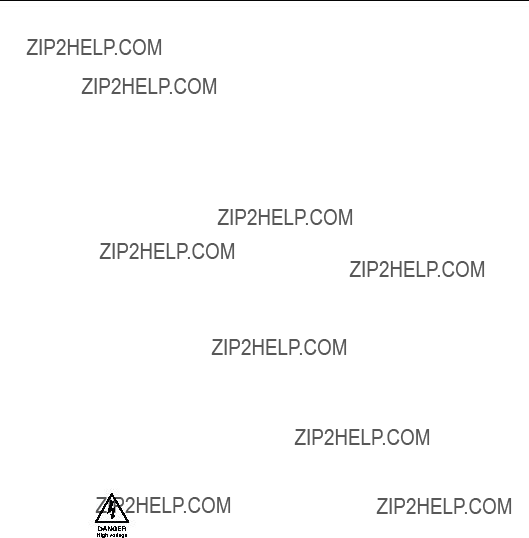
i
RayChart 420 and 420D
Chartplotter
Owner???s Handbook
SAFETY NOTICES
1. HIGH VOLTAGE.
The display unit contains high voltages. Adjustments require specialised service procedures and tools only available to qualified service technicians
??? there are no user serviceable parts or adjustments. The operator should never remove the display unit cover or attempt to service the equipment.
2. NAVIGATION AID.
This device is only an aid to navigation. Its accuracy can be affected by many factors, including equipment failure or defects, environmental conditions and improper handling or use.
It is the user???s responsibility to exercise common prudence and navigational judgement, and this device should not be relied upon as a substitute for such prudence and judgement.
RAYTHEON MARINE products are supported by a network of Authorized Service Representatives. For information on Raytheon products and services, contact either of the following:
Website www.raymarine.com
Copyright ?? Raytheon Marine Company 1999
The technical and graphical information contained in this handbook, to the best of our knowledge, was correct as it went to press. However, the Raytheon policy of continuous improvement and updating may change product specifications without prior notice. As a result, unavoidable differences between the product and handbook may occur from time to time, for which liability cannot be accepted by Raytheon.
Raytheon is a registered trademark of Raytheon Company.
Navionics is a registered trademark.
Preface
This handbook covers the RayChart 420/420D Chartplotter manufactured by Raytheon Marine Company.
It contains very important information on the installation and operation of your new equipment. In order to obtain the best results in operation and performance, please read this handbook thoroughly.
Raytheon???s Product Support representatives or your authorised dealer will be available to answer any questions you may have.
Warranty
To register your RayChart 420/420D Chartplotter ownership, please take a few minutes to fill out the warranty registration card found at the end of this handbook. It is very important that you complete the owner information and return the card to the factory in order to receive full warranty benefits.
EMC Conformance
All Raytheon equipment and accessories are designed to the best industry standards for use in the leisure marine environment.
The design and manufacture of Raytheon equipment and accessories conform to the appropriate Electromagnetic Compatibility (EMC) standards, but correct installation is required to ensure that performance is not compromised.

Table of Contentsv
Contents
Chapter 1: Overview
1.1 Introduction
How this Handbook is organised
This handbook describes the RayChart 420 Chartplotter.
The handbook is organised as follows:
Chapter 1 - Overview (this chapter) provides an overview of the features and functions of the RayChart 420 Chartplotter. You should read this chapter to familiarise yourself with the chartplotter.
Chapter 2 - Getting Started provides an overview of the controls. It also explains how to start using the chartplotter.
Chapters 3 - Operation provides detailed operating information for the main chartplotter functions - plotting waypoints and routes, following routes, showing tracks and man overboard.
Chapter 4 - Setting Up the Chartplotter provides instructions for setting up your chartplotter system to suit your preferences. It includes instructions for setting up a differential GPS. You should read this chapter to determine how to set up your system preferences.
Chapter 5 - Installation provides planning considerations and detailed instructions for installing the chartplotter.
Chapter 6 - Maintenance & Fault Finding provides information on user maintenance and what to do if you experience problems.
Appendix A lists the technical specifications for the Chartplotter.
Appendix B defines the NMEA data transmitted by the Chartplotter.
Appendix C provides a list of abbreviations used in this handbook.
An Installation Template and Warranty information are included at the end of this handbook.
General
The RayChart 420 Chartplotter is waterproof and can be installed either above or below deck. The equipment comprises:
???6 in LCD display with Chartholder compartment for a Navionics??
???GPS receiver (RC420) or Differential/GPS (dGPS) receiver (RC420D)
The RayChart 420 Chartplotter can output GPS and Waypoint data (SOG and COG) to operate with other equipment, eg. an autopilot or repeater instrument connected via the NMEA 0183 interface.
1.2 The chartplotter display
Display functions
The RayChart 420 Chartplotter includes the following functions:
???Create, Place, Move, Edit or Erase a Waypoint.
???GoTo Waypoint, Port, Facility or Cursor.
???Create, Save, Name, Edit or Follow a Route.
???Review Route and Waypoint Lists.
???Display vessel???s track
???Set Up Alarms and Timers.
???Man OverBoard (MOB) to navigate back to a missing person or object.
???Satellite acquisition data (including a Differential GPS Setup page).
???Uses positional information from GPS (RC420) or dGPS (RC420D) to display vessel???s position.
???The display and keys can be illuminated for
The chartplotter includes a 64nm world map that can be used for route planning. Detailed navigation information is displayed when a Navionics??
Your vessel???s position is shown as a boat symbol pointing in your current direction.
At the top of the chartplotter screen a status bar displays chart scale, cursor position plus range and bearing, the vessel???s position, Speed Over Ground (SOG) and Course Over Ground (COG).
Waypoints you have placed are displayed and the current route is shown. Data can be viewed for current route or chart object.
The chartplotter screen can also show additional information, depending on your currently selected options, set up selections and data available from other equipment.
An example chart display in its default configuration, with a chart card installed, is shown in Section 1.3, Operating controls.
Several functions are available to control the display as follows:
???Zoom in/out
???Pan the Display.
???Centre the Chart around the Vessel.
Operation of these functions is described in Chapter 2.
Display options
Display options are selected in System Set Up and Chart Set Up as described in
Chapter 4.
1.3 Operating controls
The chartplotter is operated by means of the following controls:
???A trackpad providing up, down, left, right and diagonal control of an on- screen cursor.
???Six dedicated
???
???Database lists, displayed
Note: The cursor is the
The controls are shown in the following illustration. They are
The following paragraphs describe the controls and
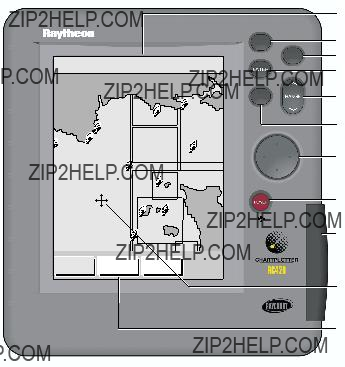
Status Bar
MOB
GOTO
GOTO key
Primary
Function Bar
D4667_1
Trackpad and cursor
The trackpad has several functions:
???To move the cursor around the chart screen.
???To select an item from a
???To adjust a control setting.
???To enter names in database lists .
Press the corresponding edge of the trackpad to move the cursor horizontally, vertically or diagonally; the longer you press, the faster the cursor moves. The current cursor position is shown in the status bar at the top of the screen.
Note: During many operations you cannot move the cursor around the screen, eg. whilst a function bar is displayed, the cursor is used exclusively for selection.
The cursor is used to:
???Select a position on the chart.
???Select, access and, if valid, move an item, eg. a waypoint, on the chart.
???Pan the chart display.
The cursor is
Dedicated keys
These keys have fixed functions. Some keys can be used in two ways:
???Press: Press the key momentarily and then release it. This method is used for most key operations.
???Press and hold: Press the key and hold it down for the period of time stated (eg. 3 seconds), then release it.
When you press a dedicated key, one of the following occurs:
1.The associated operation is actioned, eg. change chart scale (RANGE key).
2.A
3.A set of functions is displayed.
As you press a key, a single audio beep confirms the key action. If the
Function bar
The function bar at the bottom of the screen contains a number of functions which change according to the current operation. The functions are grouped into related sets and subsets providing access to the various functions. The primary function bar is displayed when you press the ENTER key.
The currently selected function is highlighted by means of a grey background.
When you invoke a function, one of the following occurs:
1.The associated operation is actioned, eg. GOTO WAYPOINT.
2.A
3.A
4.The appropriate database list (route or waypoint) is displayed.
As with dedicated keys, when you invoke the action, a single audio beep confirms the action. If the selection is not valid for the current screen or mode, three rapid beeps indicate invalid action. If required, you can turn the key beeps off as part of your set up procedure (see Chapter 4).
Use the trackpad to select an option from the menu, then use the appropriate function to set the option, eg. you can specify the radius of the waypoint arrival alarm and you can set selected navigation data on/off.
Database lists
The waypoints and routes that you create on the chartplotter are stored in database lists. You can view these lists and select items for editing.
As with
Chapter 2: Getting started
2.1 Introduction
This chapter provides information, instructions and a simple exercise to allow you to practice using the RayChart 420 Chartplotter. It is intended to help you become familiar with the controls before you start using the chartplotter for routine navigation.
Note: There is often more than one method of performing a particular task. Normal operating procedures are detailed in Chapter 3. When you become familiar with the system you can adapt these procedures to suit your method of operation.
Conventions used
Throughout this handbook, the dedicated (labelled) keys are shown in bold capitals; for example, ENTER. The functions and options are shown in normal capitals, eg. LIGHT.
Operating procedures, which may consist of a single
When textual data is displayed on screen, any unavailable data is shown as dashes, one per character.
Where procedures refer to Select, this implies using the trackpad to highlight a function, then pressing the ENTER key to action that function.
Simulator
The Chartplotter display unit includes a simulator mode, which allows you to practice operating your chartplotter without data from a GPS system. You will need to use the set up options to switch the display to simulator mode, as described in Section 2.2, Switching on/off. You can use it in either of two ways:
???Before the chartplotter has been installed on your vessel. In this case, you only need to connect the Chartplotter display unit to a 12V dc power supply, fused at 1A, connecting the red core from the power lead to positive (+) and the black core to negative
???After the chartplotter has been installed on your vessel, but while in the marina or at anchor.
2.2 Switching on/off
This section explains how to switch the chartplotter on and off.
??To turn the chartplotter display unit on, press the POWER key. The keys light up, the display unit beeps and the RayChart logo is displayed, followed by the following warning:
WARNING
THE ELECTRONIC CHART IS AN AID TO
NAVIGATION DESIGNED TO FACILITATE
THE USE OF AUTHORISED GOVERNMENT
CHARTS, NOT TO REPLACE THEM. ONLY
OFFICIAL GOVERNMENT CHARTS AND
NOTICES TO MARINERS CONTAIN ALL
INFORMATION NEEDED FOR THE SAFETY
OF NAVIGATION AND, AS ALWAYS, THE
CAPTAIN IS RESPONSIBLE FOR THEIR
PROPER USE.
Press ???ENTER??? to continue.
When you have read and understood the warning, press the ENTER key. The chart is displayed.
If this is the first time that the chartplotter has been switched on, and no chart card is installed, the display shows the
??To turn the display unit off, press and hold the POWER key for at least 3 sec- onds. A countdown timer is displayed; when it reaches zero the display and key
Changing the lighting and contrast
You can change the level of backlighting and contrast for the screen. The key backlighting remains on to enable the keys to be seen at all times.
??To change the lighting and contrast:
1. Press the POWER key to display the lighting controls:
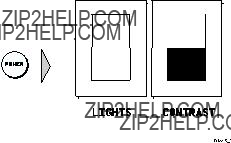
The
2.Press the trackpad left/right to select the LIGHTS function.
3.Press the trackpad top/bottom to increase or decrease the lighting to one of four levels. You can press and hold the trackpad to change the setting more rapidly. The lighting level is adjusted as you change the setting.
4.Press the trackpad right to select the contrast control. There are 16 contrast levels. Adjust the setting in the same way as for lighting to select the best level.
5.Press CLEAR to return to the chart screen, with the new lighting and contrast levels retained.
When the display unit is switched on, screen lighting is restored to ON if it was ON previously. Whilst the unit is switched on, the chosen lighting level is retained until you reset it. The new contrast level is retained until you reset it, even after
2.3 Chart simulator
When simulator mode is started, your initial simulated position is wherever the cursor was last positioned. To practice using the chartplotter in a particular chart area, use the trackpad to pan to that area, then switch simulator ON.
Note: If real position data is available (via GPS or dGPS) and the simulator is active, simulated data takes precedence. On
desired mode on
??To view a chart image using simulated data:
1. Press the PAGE key to display the SET UP function bar:

2.Press trackpad left/right to highlight SYSTEM SET UP and press ENTER to display the System Set Up menu.
3.Use trackpad up/down to highlight the SIMULATOR option .
4.Use trackpad left/right to select ON.
5.If necessary, use trackpad up/down to highlight, in turn, the SIMULATED SOG and COG options and trackpad left/right to set as required . These set Speed in 1Kt intervals and Course in 1?? intervals, respectively.
6.Press CLEAR twice to return to the chart screen.
2.4Controlling the display
This section describes how to:
???Change the display mode.
???Move around the chart by panning the display, changing the chart centre and changing the chart scale.
Selecting the display mode
Use the PAGE key to select the display mode. Select the following modes by repeat presses of the PAGE key as listed below and shown in the following illustration:
???Set Up functions (see Chapter 4)
???Course Deviation Indicator (CDI)
???Bearing & Distance Indication (BDI)
???Waypoint data
???Navigation data
???Time/Date data
???Return to Set Up functions
Note: Press GOTO to return to normal Chart display at any time.
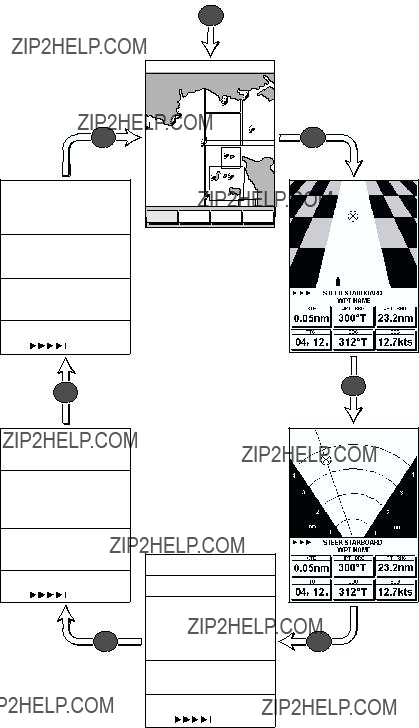
From Chart Display
Press PAGE to display Set Up functions
PAGE
Press
PAGE
to return to Set Up functions
SUNRISE 06.23
SUNSET 21.34 TODAY
AT POSITION (USER SELECTED)
50??45 .000 N
001??06 .000 W (c)
TIME 12:34 DATE 26/01/99
STEER STARBOARD
Press PAGE to display Time/Date information
POSITION
50??45 .000 N
001??06 .000 W (c)
COG 230?? T
SOG 6.8 Kts
STEER STARBOARD
Press
PAGE
to display Navigation Data
Note: In any display mode, press GOTO to return
to chart display
ROUTE
ROUTE 01
WAYPOINT
WPT 001 TO WPT 002
BRG 234?? T
RNG 12.4 nm
STEER STARBOARD
Press
PAGE
to display CDI
Press PAGE to display
BDI
Press
PAGE
to display Waypoint Data
D4724_1

Moving around the chart
You will normally operate the chartplotter with the chart showing your vessel???s current location.
In the default
Alternatively, you can home the cursor onto the vessel using the FIND SHIP function. ???Homing??? locks the vessel to the cursor and updates the display such that the chart is
Using FIND SHIP below.
There are three ways in which you can reposition the chart:
???Use the trackpad to move the cursor to the edge of the chart; the chart pans across. This method is useful if the area you wish to see is just off screen.
???Automatically
???Change the chart scale using the RANGE key to zoom out and in to a new area. This method is useful if the area you wish to see is some distance away.
Using FIND SHIP
FIND SHIP is used to
??To centre the vessel:
1. From chart mode, press ENTER; the primary function bar is displayed:
Select FIND SHIP; the following actions are performed:
???The chart is
???The cursor is homed onto the vessel position and moves with it.
???When the vessel moves near the edge of the chart window, the chart is redrawn with the vessel at the centre and the cursor homed on the vessel.
???Whilst homed, the status bar indicates vessel position, SOG and COG.
???If Screen Amplifier is enabled, the vessel is positioned so as to increase screen forward visibility, see Chapter 4, Setting Up the Chartplotter.
??To release the cursor from homed mode press the trackpad to move the cursor away from the vessel???s current position. The status bar shows the cursor position, range and bearing.

Changing the chart scale
The RANGE key allows you to change the chart scale so that you can see a smaller or larger area on the screen.
Plotter mode is available to allow you to zoom into a smaller area, even when no chart data is available for that scale. To enable plotter mode, see Chapter 4, Setting Up the Chartplotter.
You can change the chart scale for two purposes:
???To see either more detail (of a smaller area) or a larger area (in less detail) .
???To move the display to another area of the chart, by zooming out to a small scale chart, then zooming in on another position.
Each time you press the RANGE key, the chart scale changes to the next available setting. The Status Bar at the top of the screen indicates the distance, from top to bottom of the display, in nautical miles.
Vertical distance
displayed on chartIncreases the chart range
??For rapid scale change, press and hold the required arrow on the RANGE key.
The distance indicator at the
??To zoom in to a
1.Use the trackpad to position the cursor in the area you wish to see in more detail and press the bottom of the RANGE key to zoom into the area.
The section of the chart around the cursor is enlarged to fill the screen with a
The distance indicated at the top left of the screen is updated.
3.If further chart enlargement is available using the current chart card you can press the bottom of the RANGE key to zoom in again, repositioning the cursor first if required.
An area of further chart detail is indicated by a box around the area as shown in the following illustration.
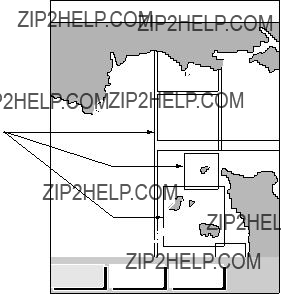
Chart Boundary -
Indicates further
detail is available inside. Shown when using Navionics??
4.If no further chart detail is available then, when you press the bottom of the RANGE key, the result depends upon whether Plotter Mode is on or off :
???If Plotter Mode is Off, the unit beeps three times and the chart scale remains unchanged, indicating the smallest chart scale is displayed.
???If Plotter Mode is On, the scale is decreased. The vessel, waypoints, routes and tracklines are displayed without cartography.
The chart information is restored when you return to a chart scale for which the information is available.
??To zoom out to a
2.5Using Navionics
The chartplotter has a
Note: To ensure maximum detail for the
To use the chartplotter as a navigation aid, charts with detailed information for the area you wish to navigate are required. The charts are available on Navionics
A
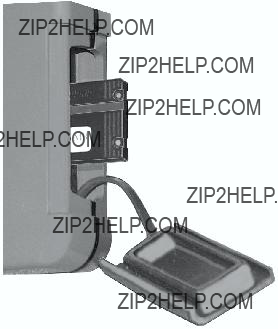
The chart scale in use is indicated in the status bar; the number represents the distance (in nautical miles) displayed from the top to the bottom of the screen.
To obtain Navionics
Navionics S.p.A. Via Vespucci 289 55049Viareggio, Italy
Tel: (+39) 584 961696
Fax: (+39) 584 961309
website: www.navionics.com
Inserting a
CAUTION
To prevent the ingress of water and consequent damage to the unit, always ensure that the cartridge cover is fully and properly inserted, whether or not a
??To insert a
1.Check that you are using the correct
2.Pull out the cartridge cover at the right hand side of the unit.
3.Hold the card with the title label and keyway slot towards you, and the two circular holes outermost, as shown below. Gently push the card into its slot until it clicks into position. It will only fit in the correct orientation.
4.To prevent the ingress of water, replace the cartridge cover.
D4706_1
Removing a
CAUTION:
DO NOT use a metallic instrument, eg. a screwdriver or pliers, to aid removal as doing so can cause irreparable damage.
??To remove a
1.Pull out the cartridge cover at the right hand side of the unit.
2.Grip the card firmly and pull to remove it from its slot.
3.To prevent the ingress of water , replace the cartridge cover.
Note: If difficulty is experienced in removing the card, a short length of cord can be secured between the two circular holes in the card to ease its removal, making sure that fitting of the cartridge cover is not impeded.
Displaying the chart data
The new chart data will be displayed when you move the cursor into an area covered by the new chart or, if it is already in the area, change the range scale.
The boundary of each chart digitized in the current card is defined by a box or rectangle. (You can switch off the chart boundaries display if you wish, as part of the chartplotter set up described in Chapter 4).
??To zoom in:
1.Use the trackpad to move the cursor inside one of the chart boxes.
2.Press the lower part of the RANGE key.
That area is expanded to show more detail. The smaller the chart box is on the screen, the greater the detail that is available when you zoom in. Unless you have activated Plotter Mode (see Chapter 4, Chart Set Up), you cannot zoom in further than the most detailed chart and you cannot zoom out further than the world map.
Displaying chart information
At large chart scales, placing the cursor over a port symbol enables detailed information to be displayed. Port information is indicated by the  symbol . The port facilities are listed in the object information
symbol . The port facilities are listed in the object information
In some areas the chart shows symbols for individual facilities. These facilities and symbols are dependent upon the particular area
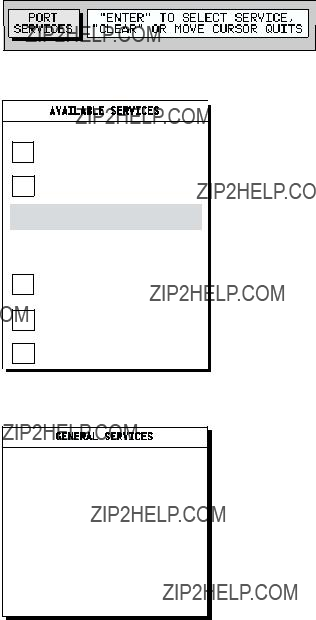
??To obtain port services information:
1.Place the cursor over the port symbol for which you require information. The PORT SERVICES function, together with help text, is displayed:
D4707_1
2.To view further details, press ENTER. The details available are listed on- screen in an object information
INFORMATION
FUEL
GENERAL SERVICES
FIRST AID
OTHER UTILITIES
WATER
REPAIR
D4708_1
3.Use the trackpad to select the required service and press ENTER to display further details:
HOTELS
RESTAURANTS
BANKS
LAUNDRIES
CAR RENTAL
FISHING/DIVING
ICE
D4709_1
4.To see more options (if available), select the .......More....... option and press ENTER.
5.Press CLEAR to remove the
Chapter 3: Operation
3.1 Introduction
This chapter explains how to use the chart functions to navigate with your RayChart 420. It covers the following topics:
???Controlling waypoints; placing, moving, editing and deleting waypoints
???Working with routes; creating a new route, managing routes using the route database and editing routes
???Going to waypoints and following routes
???Changing display modes
???Transferring waypoints and routes
???Using tracks; track set up, showing current track and converting a track to a route (SmartRoute)
???Man Overboard
???Alarms
Safety
The RayChart 420 makes it very easy to mark a waypoint and travel towards it. However, you should always check first that the route is safe. If you are using the chartplotter in combination with an autopilot connected via NMEA, the autopilot will normally prompt for confirmation before it steers the vessel towards the waypoint.
If you have entered your route using a
Note: Until you are familiar with interpreting the chart display, you should take every opportunity to compare the displayed objects with visual targets, such as buoys and coastal structures. You should practice harbour and coastal navigation during daylight and in clear weather conditions.
The equipment should not be used as a substitute for good navigational practice.
3.2 Working with waypoints
Introduction
The RayChart 420 enables you to place up to 500 waypoints. A waypoint is a position entered on a chart as a reference or destination point. All waypoints placed on the chartplotter are stored in a waypoint database list which includes symbol, position, bearing, range, date and time.
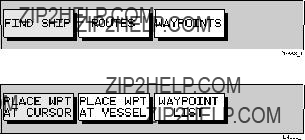
All waypoints in the database are displayed on the screen, unless you set SHOW WAYPOINTS to OFF in the Chart Set Up menu, as described in Chapter 4. You can select a waypoint, either
The waypoint is usually placed at the cursor position and can be part of a route; you can also place a waypoint at the vessel???s current position. You can place waypoints before you install the chartplotter on your vessel.
When you place a new waypoint, it is displayed using either the default symbol of a cross or an alternative symbol available from the Chart Set Up menu, as described in Chapter 4. The waypoint is added to the waypoint list and named with the next available number. You can use the edit functions to change the symbol and name. When the cursor is positioned over a waypoint, the waypoint bearing and range are displayed.
You can also transfer waypoints between the chartplotter and other NMEA connected instruments using the Waypoint Transfer functions.
This section explains how to perform the following tasks using the
???Placing a Waypoint
???Selecting a Waypoint
???Displaying Waypoint data
???Editing a Waypoint (symbol, name & position)
???Erasing a Waypoint
???Moving a Waypoint
Placing a waypoint
Note: It is not possible to place multiple waypoints at the same position.
??To place a new waypoint:
1.From chart mode, press ENTER; the primary function bar is displayed:
2.Using trackpad left/right, select WAYPOINTS.
??To place a waypoint at the cursor position:
1.Select PLACE WPT AT CURSOR . The selected function now has help text appended to it:
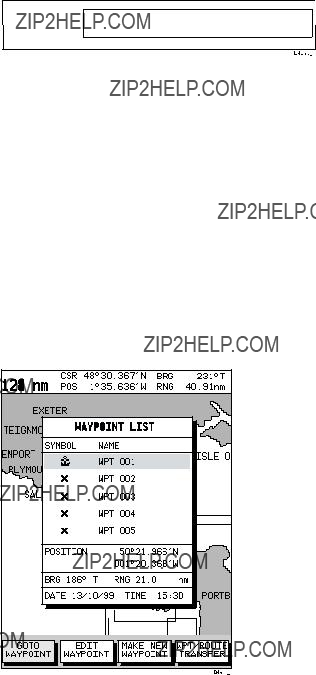
2.Place the cursor in the required position on the chart and press ENTER to place the waypoint. The waypoint is added to the waypoint list and named using the next available number.
The waypoint functions remain displayed so that you can place further waypoints.
If required, use EDIT WAYPOINT to name the waypoint as described in
Editing Waypoints below.
3.When finished placing waypoints, press CLEAR.
??To place a waypoint at the vessel???s position:
1.Select PLACE WPT AT VESSEL.
A new waypoint is placed at the vessel???s current position.
??To place a waypoint using the Waypoint List:
1.Select WAYPOINT LIST . The Waypoint List and associated functions are displayed:
2.Select MAKE NEW WAYPOINT.
The waypoint is placed at the current vessel position or, if a GPS fix is not available, the cursor position. The new waypoint is added to the Waypoint List and named with the next available number.
To return to chart mode, press CLEAR twice.
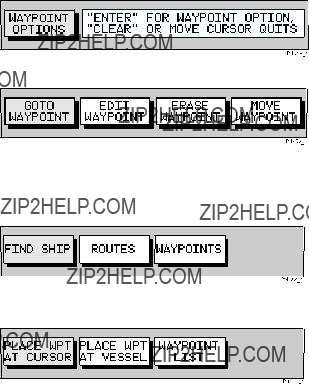
Selecting a waypoint
Positioning the cursor over a waypoint selects that waypoint and accesses the WAYPOINT OPTIONS function bar. This enables you to go to (described in Section 3.4), edit (symbol, name, position), erase or move the waypoint.
Selecting a waypoint from the Waypoint List allows you to go to and edit (symbol, name, position, erase) the waypoint. The Waypoint List also provides options to make a new waypoint and transfer waypoints.
??To select a waypoint using the cursor:
1.Move the cursor over the waypoint; the WAYPOINT OPTIONS function bar, together with help text, is displayed:
2.Press ENTER to select the waypoint function bar:
The selected waypoint can be edited via these functions.
??To select a waypoint using the Waypoint List:
1.Press ENTER to display the primary function bar:
2.Select WAYPOINTS and press ENTER to display the waypoint function bar:
3.Select WAYPOINT LIST and press ENTER to display the Waypoint List. The Waypoint List and associated function bar are displayed (see Placing a waypoint).
The list details all waypoints. The selected waypoint is indicated by the highlight bar with its position; bearing and range are provided (if GPS fix available).
4.Use trackpad up/down to move through the list to highlight the required waypoint.
The selected waypoint can be edited using the EDIT WAYPOINT function.

Waypoint data display
Waypoint data can be viewed in two ways: you can use the cursor to select the waypoint to display the waypoint data in the status bar at the top of the screen, or you can view waypoint details on the waypoint list.
??To display waypoint data:
Move the cursor over the waypoint. The waypoint data is displayed in the status bar, indicating waypoint number/name, bearing and range.
Whilst the cursor is over the waypoint, the WAYPOINT OPTIONS function bar is displayed.
??To remove the waypoint data :
Move the cursor away from the waypoint or press CLEAR.
??To display the waypoint details from the waypoint list:
Select the waypoint in the list as described above.
The details for the selected waypoint are displayed in the lower half of the window. Date and time are included for all waypoints.
To remove the Waypoint List and return to chart mode, press CLEAR twice.
Editing the waypoint details
You can change the name, symbol and position of a waypoint, which can be achieved either by means of the cursor or via the Waypoint List.
Note: You cannot edit the target waypoint.
??To edit a waypoint using the cursor:
1.Place the cursor over the waypoint, see Selecting a waypoint above.
2.Select EDIT WAYPOINT. The Edit Waypoint function bar is displayed:
3.To edit the waypoint name, select EDIT NAME. The NAME WAYPOINT window is displayed. Use the trackpad to enter or edit the name as follows:
???Use trackpad left/right to move the cursor to the character you wish to change. Up to eight characters can be used.
???Use trackpad up/down to scroll through the characters.
When you have finished editing the name press ENTER. The waypoint name is updated and the window is removed
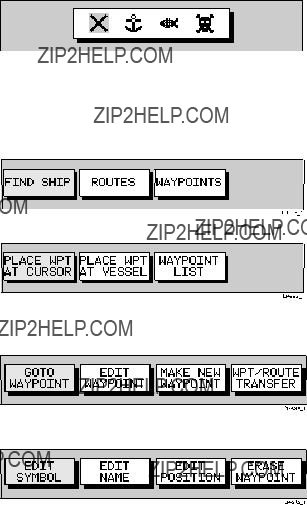
4. To edit the symbol, select EDIT SYMBOL.
D4674_1
5.Use trackpad left/right to highlight the required symbol , then press
ENTER.
??To edit a waypoint using the Waypoint List:
1.From chart mode, press ENTER; the primary function bar is displayed.
2.Using trackpad left/right, select WAYPOINTS.
3.Select WAYPOINT LIST.
The Waypoint List is displayed, with its associated function bar:
4.Select EDIT WAYPOINT; the waypoint edit functions are displayed:
5.To edit the waypoint name, select EDIT NAME.
The cursor is placed in the name field of the selected waypoint. Edit the name as previously described (up to eight characters).
6.Edit the waypoint symbol as previously described, using the cursor.
7.To change the waypoint???s position, select EDIT POSITION. The cursor is placed in the Position field in the Waypoint List .
???Use trackpad left/right to select the latitude/longitude fields.
???Use trackpad up/down to scroll through and edit the values.
8.When you have finished editing, press ENTER to save the new position.

Erasing a waypoint
Note: You cannot erase a waypoint that is the target waypoint or waypoints that are also used in any saved route(s).
If you try to erase a waypoint that is used in a saved route you are warned
???WAYPOINT IS USED IN ROUTE(S) AND CANNOT BE ERASED???
??To delete a waypoint using the cursor:
1.Place the cursor over the waypoint; see Selecting a waypoint above.
2.Select ERASE WAYPOINT. A warning box appears. Press ENTER to erase or CLEAR to retain. If erased, the waypoint list is updated and the screen is cleared.
??To delete a waypoint using the waypoint list:
1.Select the waypoint from the waypoint list as previously described. The waypoint list function bar is displayed.
2.Use trackpad up/down to move through the list to highlight the required waypoint.
2. Select ERASE WAYPOINT. Press ENTER to erase the waypoint.
To return to chart mode, press CLEAR three times.
Moving a waypoint
You can move any waypoint except the target waypoint. You can use the Waypoint function bar and cursor to move the selected waypoint, or you can edit the waypoint position.
Note: Take care when editing waypoints as it is possible to move waypoints that are used in routes stored in the Route Database List.
??To move a waypoint using the cursor:
1.Place the cursor over the waypoint; see Selecting a waypoint above.
2.Select MOVE WAYPOINT. The selected function now has help text appended to it:
CURSOR SELECT POS, "ENTER"
MOVES WPT, "CLEAR" TO QUIT
3.Move the cursor to the required waypoint position.
4.When the cursor is in the correct position, press ENTER to set the new position and return to normal cursor control.
To return to chart mode, press CLEAR.

??To move a waypoint using the Waypoint Edit functions:
1.Select the waypoint using the Waypoint List as described above. The waypoint functions are displayed.
2.To edit the waypoint position proceed as previously described in Editing the Waypoint Details.
3.3Working with routes
A route is made up of a series of waypoints (maximum 50). To make a route you place a series of waypoints on the chart.
When a route is created it becomes the current route and is displayed
When you have created a route you can use the GOTO key to follow the route. The GOTO key provides various other options as described in Section 3.4.
Up to 20 routes can be saved in the route database. You can then select a route from the database list to be used as the current route.
The current route can be edited by adding and/or moving waypoints. When a route has been saved, options are also provided to name a route or erase a route.
This section explains how to perform the following tasks:
???Create a new route.
???Save the current route in the database list.
???Clear the current route.
???Retrieve a route from the database list as the current route.
???Display route information, including the route leg data and waypoint details.
???Use the database list to erase and name existing routes.
???Edit a route by adding, removing and moving waypoints.
??To access the route function bar:
1. Press ENTER to display the primary function bar:
2. Select ROUTES to display the first level functions:
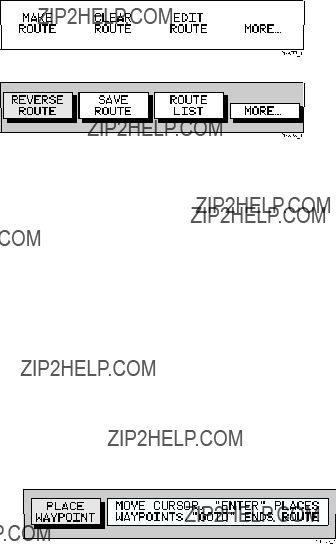
3.Select MORE to see more functions:
4.Select MORE again to return to the first level functions.
5.Press CLEAR to return to chart mode.
Creating a new route
Note: If there is a current route on screen, it is cleared when you select MAKE ROUTE. If you are following the current route you are prompted to STOP FOLLOW. Press ENTER to continue or CLEAR to abandon route creation. If the route has not been saved you are prompted to save it.
You can add/remove waypoints in a route after you have finished making it, either via the ROUTES function or via the cursor (see Editing a Route in the following sections).
??To make a new route by placing waypoints:
Note: You can pan the chart and change the scale whilst placing waypoints.
1.If necessary, move the cursor to the area in which you wish to make the route and select a suitable chart scale.
2.Select ROUTES then MAKE ROUTE. The MAKE ROUTE function is replaced with PLACE WAYPOINT, together with help text:
3.Move the cursor to the position on the chart where you want your first waypoint to be placed and press ENTER.
Note: You can position the cursor on an existing waypoint, if required; the PLACE WAYPOINT function changes to USE THIS WAYPOINT . Press
ENTER to use the waypoint.
The waypoint appears on the screen at the cursor position. The number displayed alongside the waypoint identifies its position in the route.
Note: If you Clear the route before it is saved, the waypoint is removed.
4.Move the cursor to the next waypoint position; a dotted line connects the cursor to the last placed waypoint.
5.Press ENTER again. The next waypoint is placed and the dotted line changes to a solid line.
Note: If you placed a waypoint incorrectly, you can delete it by pressing CLEAR . Successive waypoints can be deleted in this way.
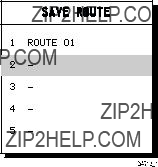
6.Repeat steps 4 and 5 until you have placed all your waypoints. You can have up to 50 waypoints in a route. Any existing waypoint(s) can be included by placing the cursor on the waypoint(s).
7.When you have entered all your waypoints, press GOTO to complete the route. Your route is displayed on the screen and is the current route, but is not active, ie. not being followed.
8.Select MORE to access the SAVE ROUTE function, or ENTER to return to chart mode.
Note: The completed route is stored in the unit???s memory and will be re- displayed if you turn the unit off and on again. However, it is recommended that you save the route as described below. The current route waypoints do not appear in the waypoint list until the route is saved.
Saving the Current Route
You can save up to 20 named routes in the route database list. These routes can then be
Note: When you attempt an operation affecting this route (eg. CLEAR ROUTE) before the current route is saved, you are prompted to save it.
??To save and name the current route:
1.Select ROUTES, followed by MORE.
2.Select SAVE ROUTE. The Save Route list is displayed.
3.The next available entry on the list is highlighted . (If required, you can use trackpad up/down to select another position in the list; this can be a blank slot, or an existing route that you no longer require).
4.Press ENTER to save the route. Press ENTER again (in response to the prompt) to name the route or CLEAR to save as the default ROUTE XX, where XX is the next available number.
When naming a route, use the trackpad to move the cursor right or left to the character you wish to edit. Use trackpad up/down to scroll through the characters or numerals. The name can contain up to eight alphanumeric characters, including spaces.
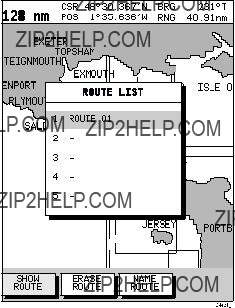
5.Press ENTER to finish and clear the Route List, then press CLEAR to return to the chart mode.
Clearing the current route from the screen
To clear the current route from the screen, select CLEAR ROUTE. If the current route has not been saved, you are prompted to save it.
??To clear the current route from the screen:
1.Select ROUTES or place the cursor over a route leg until the leg data is displayed in the Status Bar.
2.Select CLEAR ROUTE and press ENTER to clear the route or press CLEAR to cancel the operation.
3.If the route has not been saved, a prompt gives the options ENTER to save or CLEAR to remove the route from the screen.
4.To save the route in the database, press ENTER. The Name Route functions are displayed , see Saving the Current Route above.
Retrieving a route from the database
You can select a route as the current route from the database list. The list is accessed from the second set of ROUTES functions.
??To select a route as the current route:
1.Select ROUTES, followed by MORE, then ROUTE LIST. The route list is displayed with the currently selected route highlighted:
2.Select SHOW ROUTE. The route list is removed and the selected route is shown on screen as the current route.
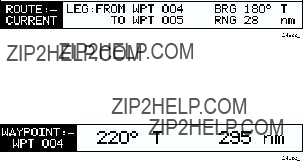
Displaying route leg and waypoint information
??To display information about a route leg, move the cursor over the leg until its data is displayed in the status bar at the top of the screen.
To remove the data, move the cursor away from the route leg or press CLEAR.
??To display information about a route waypoint, move the cursor over the waypoint until its
To remove the data, move the cursor away from the waypoint or press CLEAR.
Erasing or (re)naming a route
You can delete a route or
??To select a route to delete:
1.Select ROUTES, followed by MORE, then ROUTE LIST. The route list is displayed with the selected route highlighted.
2.Select ERASE ROUTE.
3.Press ENTER to erase the route from the list. Press ENTER again to confirm or CLEAR to cancel the operation.
4.Press CLEAR three times to remove the route list and return to chart mode.
??To select a route to (re)name:
1.Select ROUTES, followed by MORE, then ROUTE LIST. The route list is displayed with the selected route highlighted.
Select NAME ROUTE.
2.To name or rename a route, use trackpad left/right to select the character you wish to edit. Use trackpad up/down to scroll through the characters or numerals.
3.Press ENTER to accept the new name or CLEAR to cancel the operation.
4.Press CLEAR to clear the Name List. To return to chart mode, press CLEAR again.
Editing a route
You can edit a route in order to:
???Add a Waypoint into a route
???Remove a Waypoint from a route
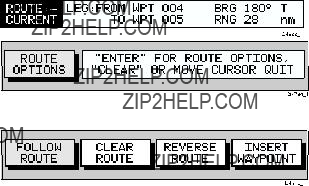
???Move a Waypoint (as described in Section 3.2)
???Reverse a Route
Any changes you make to the route affect only the current route, so you need to save the route if you want to keep the changes.
Inserting/deleting waypoints in a route
??To add a waypoint to the end of a route:
Note: If no current route is displayed, select a route from the Route List and use the SHOW ROUTE function to make it active, see Retrieving a route from the database.
1.Select EDIT ROUTE and press ENTER; the PLACE WAYPOINT function is shown as above (see Creating a new route).
2.Add waypoints to the route by moving the cursor and pressing ENTER in the same way as the route was first created.
3.Remove waypoints from a route by pressing CLEAR in the same way as the route was first created.
Note: When deleting waypoints, if the route has not been saved, the waypoint is erased. If the route has been saved, the waypoint remains on the screen.
??To insert a waypoint into a route:
1.Move the cursor over the route leg into which you wish to insert a waypoint. The route leg data is shown in the status bar and the ROUTE OPTIONS function, with help text, is displayed:
2.Press ENTER; the Route Leg functions are displayed:
3.Select INSERT WAYPOINT.
The cursor now controls the new waypoint which is connected to the existing waypoints on either side with a dotted line. The subsequent waypoint(s) are renumbered accordingly.
4.Using the trackpad, place the new waypoint and press ENTER.
5.Move the new waypoint to the required position and press ENTER to place it and return to normal cursor operation or CLEAR to cancel the operation.
6. Press CLEAR again to remove the function bar and route leg data.
The new waypoint is temporarily added to the waypoint list and named with the first available waypoint number. The waypoints in the current route are re- numbered to identify the new positions.
??To remove a waypoint from the route using the cursor:
1.Place the cursor over the waypoint; see Selecting a waypoint in Section 3.2.. The Waypoint functions are displayed.
2.Select REMOVE WAYPOINT; the waypoint is removed from the route.
3.4Following routes and going to target points
The GOTO key accesses the functions to follow a route or go to a waypoint, port or current cursor position. When you select the target destination, the chartplotter calculates bearing, distance and cross track error; this information can be displayed or passed to an autopilot via NMEA. You can also restart the Cross Track Error (XTE) from the actual vessel position to set XTE to zero at that point.
When the chartplotter is following a route, the target destination is indicated by a square around the waypoint (or cursor marker) and a dotted line shows the intended track, from your start point or previous waypoint, to the target waypoint.
This section explains how to perform the following tasks:
???Follow a route.
???Reverse a route.
???Target Point Arrival.
???Altering the route, including joining at a selected waypoint, advancing waypoints and restarting XTE.
???Go to an individual point, either an existing waypoint or the cursor.
???Go to the nearest or a selected port.
???Stop and Restart Follow/Goto.
An alarm is triggered when you approach a waypoint. Chapter 4 describes how to set the alarm.
??To access the follow and goto functions:
1. Press the GOTO key to display the first level GOTO functions:
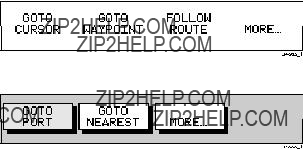
2.Select MORE to display the second level GOTO functions:
3.Select MORE to return to the first level functions.
4.Press CLEAR to return to the chart screen.
Note: The functions differ if a FOLLOW or GOTO is already in progress (see Stop Follow or Stop Goto).
Follow a route
Note: If a route has been reversed or if a route on screen was being followed but stopped before completion, the target waypoint ??? outlined by a square box ??? may be different to when the route was created. You should always check the target waypoint before initiating a follow route.
??To follow the current route:
1.Press the GOTO key. The Goto/Follow functions are displayed. Alternatively, place the cursor over a route leg until the Route functions are displayed.
2.Select FOLLOW ROUTE.
Your vessel???s current position becomes the origin and the first waypoint in the current route becomes the target waypoint. A dotted line connects the vessel???s current position to the target waypoint. This line remains fixed on screen as the vessel moves. The function bar is removed.
Reverse a route
This option enables a return route to be generated from an existing route which is then followed in reverse order, with waypoints renumbered accordingly.
??To reverse the current route:
1. From the normal chart display either:
a)Press ENTER to display the primary function bar, then select ROUTES, followed by MORE, then REVERSE ROUTE.
or b) Move the cursor over a route leg or waypoint until the ROUTE OPTIONS function is displayed. Press ENTER to display the options and select REVERSE ROUTE.

The current route is reversed on the screen and the waypoints are renumbered.
??To follow the reversed route:
4.Press the GOTO key. The Goto/Follow functions are displayed.
5.Press FOLLOW ROUTE.
Your vessel???s current position becomes the origin and the first waypoint in the reversed route becomes the target waypoint. The function bar is removed.
Target point arrival
You can set up target alarms (see Chapter 4) to alert you when the vessel is approaching the target point. The arrival alarm is defined as a circle (not visible on the screen), with a specified radius around the target.
The alarm is triggered when either of the following conditions is met:
???The distance to the target point is less than that specified for the Arrival alarm.
???Your vessel reaches the closest point of approach to the target (ie. it crosses a line passing through the waypoint and perpendicular to the track).
??To cancel the Arrival alarm and go towards the next waypoint in the route, press any key.
The target becomes the origin, the next waypoint becomes the target point and the two are connected by a dotted line indicating the current leg.
If the target waypoint was the subject of a GoTo, or was the last waypoint in a route, the
Alter a route
You can use the functions to follow a route from a selected waypoint (Join a route) or, if already following, you can advance to the next waypoint. You can also restart the XTE, setting the current vessel position as the new origin.
In addition, you can move a selected waypoint as described in section 3.2, or remove a waypoint from the route as described in section 3.3.
Join a route
??To start following the current route from a selected waypoint:
1.Move the cursor over a route waypoint until the ROUTE OPTIONS function is displayed:
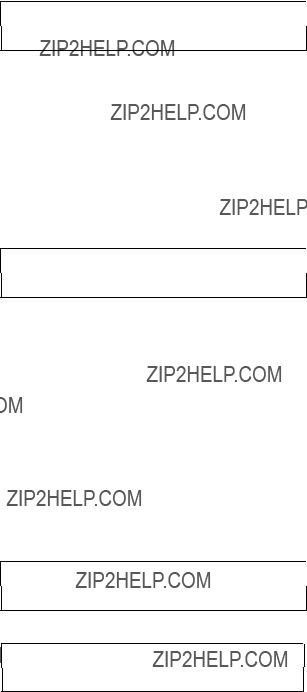
2. Press ENTER and select FOLLOW FROM HERE.
D4687_1
Your vessel follows the route, using the selected waypoint as the target.
3.To return to chart mode, move the cursor away from the waypoint or press
CLEAR.
Advance to a waypoint
When following a route you can advance to the next waypoint, even if you have not reached the current target waypoint.
??To advance to a waypoint:
1. Press the GOTO key to display the Goto/Follow functions:
D4688_1
2.Select WAYPOINT ADVANCE. The current leg of the route is abandoned and the next waypoint becomes the target. The display is updated to show the new route leg.
Restart Cross Track Error (XTE)
Reset XTE is useful if you find yourself off track and want to go straight to your target, rather than get back onto the original track.
Whilst following a route, or going to a target point, you can restart the XTE. This sets the XTE to zero and moves the origin to the vessel???s actual position.
??To restart XTE:
1.Press the GOTO key.
If following a route, the following functions are displayed:
D4688_1
If a GOTO is already in progress, the following functions are displayed:
D4689_1
2.Select RESTART XTE. The dotted line between the previous and next waypoints is redrawn from the vessel???s current position to the next waypoint and the XTE is reset to zero
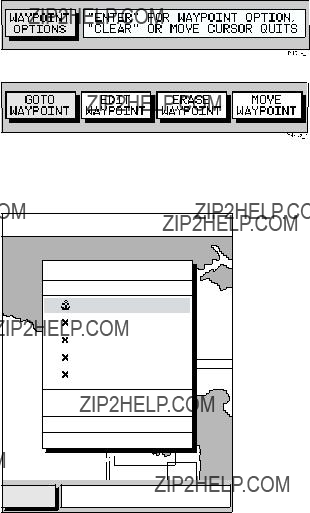
Going to an individual target
Rather than following a route, you can go directly to a selected target. This can be an existing waypoint, a port or the current cursor position.
Go to a waypoint
??To navigate directly to an existing waypoint:
1.From the normal chart display either:
a)Use the trackpad to position the cursor over the required waypoint until the waypoint options function is displayed:
...then press ENTER to display the waypoint functions:
or b) press the GOTO key to display the waypoint options and select GOTO WAYPOINT; the waypoint list appears. Use the cursor to select the required waypoint:
D4690_1
Alternatively, you can select the waypoint from the waypoint list as described in section 3.2
2.Select GOTO WAYPOINT.
A dotted line is drawn between the vessel???s current position and the selected waypoint and navigation to the selected waypoint begins.

Go to cursor
Note: If navigation is currently in progress or if the cursor is homed (Find Ship) it is not possible to go to cursor.
??To navigate directly to the current cursor position:
1.Press the GOTO key and select GOTO CURSOR. The GOTO CURSOR function now has help text appended to it:
D4691_1
2.Use the trackpad to position the cursor as required.
3.Press ENTER to start the GoTo, or CLEAR to cancel the operation. A temporary waypoint is placed at the cursor position and navigation proceeds towards it. The waypoint is shown as a square with a dot in the centre and is connected to the vessel???s starting position with a dotted line.
On arrival, the arrival alarm is sounded and the arrival
Note: The temporary waypoint is not added to the waypoint list; when the GoTo is complete, or is stopped, the temporary waypoint is erased.
Go to a port
You can navigate directly to the nearest port or to a selected port or facility.
??To navigate directly to selected port:
1.Press the GOTO key and select GOTO PORT to display the Port List.
2.Use trackpad up/down to select the required port and press ENTER to start the GoTo, or CLEAR to cancel the operation.
A dotted line is drawn between the current vessel position and the target waypoint which is placed at the port. The line remains fixed on the screen as the vessel moves.
Bearing, Range and Cross Track Error are calculated for the target waypoint in the same manner as for GOTO CURSOR.
On arrival, the arrival alarm is sounded and the arrival
??To navigate directly to the nearest port or facility:
1.Press the GOTO key and select GOTO NEAREST to display the list.
2.Use trackpad up/down to select the required facility and press ENTER to start the GoTo, or CLEAR to cancel the operation.
The list shows the eight nearest places where the selected facility exists, in order of distance. The bearing and range (in selected units) for each one is shown.
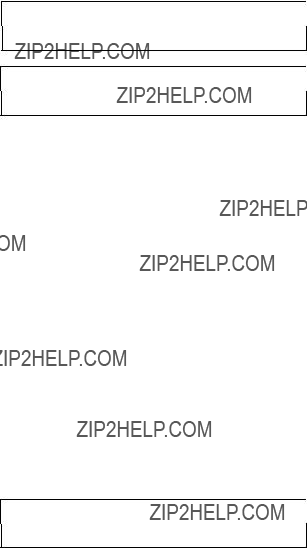
3.Use trackpad up/down to select the required destination and press ENTER to start the GoTo, or CLEAR to cancel the operation.
The operation is conducted in the same manner as for GO TO PORT above.
Stop follow or stop goto
??To stop following the route or target point:
1.Either press the GOTO key or move the cursor over the target waypoint.
2.Select the STOP GOTO or STOP FOLLOW function respectively:
D4688_1
The dotted line from your vessel to the target waypoint disappears.
3.5 Changing the display mode
Use the PAGE key to select the required display mode. Repeat presses of the PAGE key provide the following display modes:
???Set Up functions (see Chapter 4)
???Course Deviation Indicator (CDI)
???Bearing & Distance Indication (BDI)
???Waypoint data
???Navigation data
???Time/Date data
???Return to Set Up functions
Note: Press GOTO in any display mode to return to normal Chart display.
??To change the display mode:
1.Press the PAGE key to show the SET UP functions with SYSTEM SET UP highlighted:
2. Repeat Step 1 to cycle through each of the available display modes.
Note: The Set Up Function Bar remains displayed in each display mode.
To remove the Set Up Function Bar, press CLEAR.
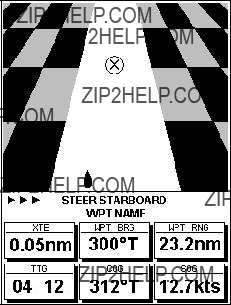
CDI display
The CDI display shows Cross Track Error (XTE) and distance to waypoint presented in a ???runway??? format:
D4700_1
The ???runway??? represents a 0.3nm width with the vessel symbol shown at the bottom. Bearing to Waypoint, Distance to Waypoint, Time to Go (TTG), Course Over Ground (COG) and Speed Over Ground (SOG) are also shown. Time to Go is calculated on the basis of distance to destination and Speed Over Ground (SOG) towards the destination.
At waypoint ranges greater than 4nm, the symbol remains at the top of the screen. As the waypoint range falls below 4nm, the symbol moves down the centre line.
The chequered pattern moves down the screen to simulate movement when SOG is greater than 2 knots.
The steering instruction is STEER STARBOARD if the XTE is 0.01nm or more to port, STEER PORT if the XTE is 0.01nm or more to starboard or ON COURSE if the XTE is less than 0.01 on either side. If no GOTO or follow is in progress, the steering instruction is NO TARGET.
The graphical XTE indication places arrows either side of the steering instruction and pointing towards it, dependent on the value of XTE.
The first arrow is shown when the XTE reaches 0.01nm, the second at .05nm and subsequently at 0.1nm intervals .
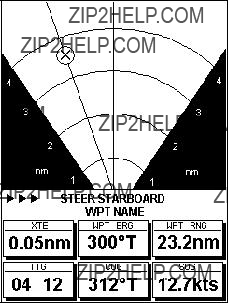
BDI display
The BDI display shows deviation from the bearing to waypoint and distance to waypoint. Cross track Error, Bearing to Waypoint, Distance to Waypoint, Time to Go, COG and SOG are also shown. Time to Go is calculated on the basis of distance to destination and velocity made good towards destination.
D4701_1
The line to the waypoint symbol is shown at an angle equal to the difference between the COG and the Bearing to Waypoint. The waypoint symbol is the symbol of the target waypoint as seen on the chart.
The range scale automatically scales for distance. The ranges shown are 4nm, 20nm, 40nm, 100nm, 200nm, 400nm, 1000nm, 2000nm, 4000nm. In each case the range scale has graduations at ??, ?? and ?? of the current scale.
The steering instruction is STEER STARBOARD if the waypoint line is 1?? or more to port, STEER PORT if the waypoint line is 1?? or more to starboard or ON COURSE if the waypoint line is dead ahead. If no GOTO or follow is in progress, the steering instruction is NO TARGET, no steering arrows are shown, but the rhumb line indicator is shown.
The graphical XTE indication will place arrows either side of the steering instruction and pointing towards it dependent on the difference between COG and bearing to Waypoint. The first arrow is shown when the difference reaches 5?? and thereafter at 5?? intervals.
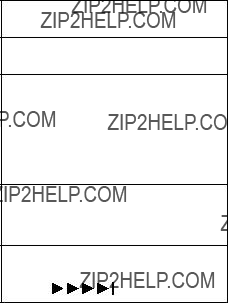
Waypoint data
The Waypoint Data display comprises text data occupying the whole screen :
ROUTE
ROUTE 01
WAYPOINT
WPT 001
BRG 234?? T
RNG 12.4 nm
STEER STARBOARD
D4702_1
If a route is not selected, the ROUTE field displays NO ROUTE.
The WAYPOINT field shows the name of the waypoint. If the waypoint is part of a route then the title field includes the waypoint index in the route. If there is no target waypoint the text indicates NO WAYPOINT and all waypoint data is shown as dashes, one per character. If a route is being followed and the waypoint is not named, the text shows the waypoint number within the route (as displayed on screen). If a GOTO Cursor or Port is in progress, the text indicates GOTO CURSOR or GOTO ???Port Name???.
BRG, RNG and XTE data relate to the target waypoint.
The Time refers to local time and is set in the System Set Up menu, Chapter 4.
The Time To Go (TTG) and Estimated Time of Arrival (ETA) data relate to the target waypoint (not the whole route) and are based on the Speed Over Ground (SOG) towards the target. If the VMG is negative, or data is not available, these fields are replaced by dashes, one per character.
The steering instruction is STEER STARBOARD if the XTE is 0.01nm or more to port, STEER PORT if the XTE is 0.01nm or more to starboard or ON COURSE if XTE is less than 0.01 on either side.
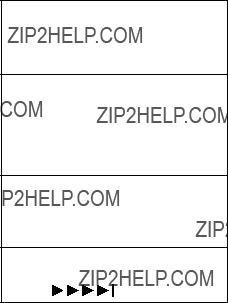
If no GOTO or follow is in progress, the steering instruction is NO TARGET, no steering arrows are shown, but the rhumb line indicator is shown.
The graphical XTE indication places arrows either side of the rhumb line indicator and pointing towards it, dependent on the value of XTE. The first arrow is shown when the XTE reaches 0.01nm, the second at .05nm and subsequently at 0.1nm intervals .
Note: The steering instruction and graphical XTE indication are repeated on all
Navigation data
The Navigation Data display comprises text data occupying the whole screen:
POSITION
50??45 .000 N
001??06 .000 W (c)
COG 230?? T
SOG 6.8 Kts
STEER STARBOARD
D4703_1
Textual data provides Position, SOG, COG, Bearing and Range to waypoint, Time, Fix status and the XTE indicator. Any unavailable data is replaced by dashes, one per character. When there is no GPS fix but there is a value for the last fix, this is shown instead; POSITION is replaced with LAST POSITION.
The (c) indicator only appears when the position has been user calibrated.
The Fix indicator shows the GPS Fix status and indicates either FIX OK or NO FIX. In the case of a differential fix,
Note: Graphical XTE indicator is as per Waypoint data screen, see above.
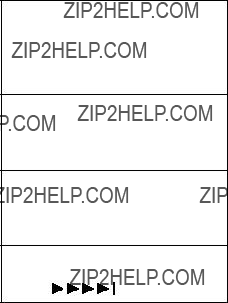
Time/Date Data
The Time/Date display comprises text data occupying the whole screen:
TIME 12:34
DATE 26/01/99
STEER STARBOARD
Textual data provides Sunrise and Sunset time, Current Time/ Date, Waypoint and Route arrival times plus the XTE indicator.
Sunrise and Sunset times are for the selected day and at the selected position. The TODAY indicator emphasises that the sunrise and sunset times relate to the current day. If you select another day, the TODAY text is replaced with ON XX/XX/XX where XX/XX/XX is the selected date in the current format.
When the Time/Date screen is first opened, the data relates to the current day, unless there is no date information available. In this case the last date is used. The vessel???s current position is used unless there is no GPS fix in which case the cursor position is used and shown as a USER SELECTED position.
The position data can be either as selected by you, in which case the text relating to the position is USER SELECTED, or the current position in which case the text is VESSEL.
The (c) indicator only appears when the position has been user calibrated.
The Time and Date fields show the local current time and date.
The TTG and ETA (WAYPOINT) data relates to the target waypoint. The TTG and ETA (ROUTE) data relates to the end of the route.
All data is based on the SOG towards the current target. If the SOG is negative, or data is not available, these fields are replaced with dashes, one per character.
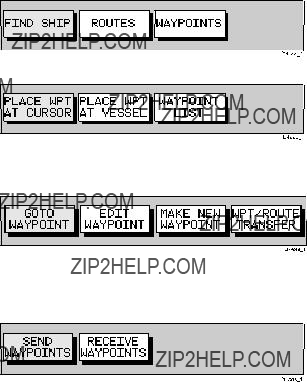
3.6 Transferring waypoints and routes
Displayed waypoints
Waypoints and routes can be received and transmitted via NMEA, see also
Chapter 5, Section 5.4, Connecting to other equipment. The NMEA link could be to a PC.
Managing database lists
The SEND WAYPOINTS function sends all waypoints in the Waypoint List and all routes in the Route List. Sending the Waypoint List does not affect current routes.
Note: Sending the Waypoint List includes waypoints in an unsaved route.
The RECEIVE WAYPOINTS function adds waypoints and routes received via NMEA to the Waypoint List and Route List.
Note: Where multiple waypoints have the same position, the last waypoint sent is the only one included in the Waypoint List.
??To send waypoints (and route lists):
1.From chart mode, press ENTER; the primary function bar is displayed:
2.Using trackpad up/down, select WAYPOINTS.
3.Select WAYPOINT LIST.
The Waypoint List is displayed, with its associated function bar:
4.Initiate receiving of waypoints on the NMEA compatible equipment.
5.Select WPT/ROUTE TRANSFER.
The waypoint transfer functions are displayed:
6.Select SEND WAYPOINTS and press ENTER; the text changes to
STOP SENDING.

7.To stop waypoint transfer, press ENTER.
??To receive waypoints and route lists:
1.Display the Waypoint List as previously described, then select
WPT/ROUTE TRANSFER.
2.Select RECEIVE WAYPOINTS and press ENTER; the text changes to STOP RECEIVING and remains selected.
3.Initiate sending waypoints on the NMEA compatible equipment.
4.To stop waypoint transfer, press ENTER.
Note: If either the Waypoint List or Route List becomes full, a warning is displayed and the operation is terminated.
3.7 Using tracks
The Track function is used to mark an
While the track is turned on, it is recorded in the display unit???s memory. You specify the interval at which track points are made and a line is drawn
The track remains
Using the SmartRoute function, a track can also be converted to and saved as a route which is automatically reversed, ready for use as your return voyage.
This section describes how to:
???Set up a track and specify the interval between track points.
???Clear the current track.
???Convert the track to a route (SmartRoute).
??To access the track controls:
1.From chart mode, press the PAGE key to display the chart set up function bar:
2.Select TRACK SET UP to display the Track function bar:
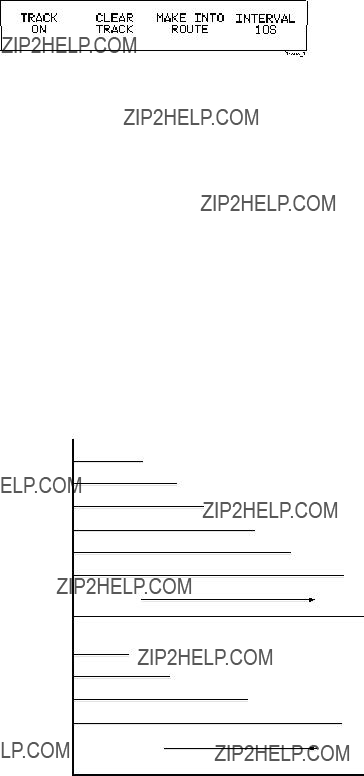
The following instructions assume that the track functions are displayed.
Setting up a track
Use the track functions to switch the track on and to specify the interval at which track points are placed. The time interval between track points can be set to 1s, 10s, 30s, 1min, 10min or 30 minutes. The distance spacing between track points can be set to 0.05nm, 0.1nm, 0.5nm or 1nm. The maximum track length is 2000 points. When this limit has been reached, track points continue to be placed, but the oldest points start to be deleted. Track ponts continue to be placed until you switch track off; the current track is retained even when the unit is powered off.
Setting a short time interval between track points is best suited to navigation within a close or complex environment, eg. an estuary or marina whereas, in contrast, a greater distance interval is best suited to a long haul voyage.
When complete, a track can be converted to and saved as a route (SmartRoute).
Refer to the setting guide shown below to determine the best setting for your planned voyage; this is particularly important if you wish to use SmartRoute to convert your track to a route.
Track Interval Setting Guide
??To set up a track:
1.Select the INTERVAL function.
Use trackpad up/down to select the appropriate options to set either a time interval or a distance interval; press up to increase the interval or down to decrease the interval.
2.Use trackpad left/right to select TRACK ON and press ENTER. The TRACK ON text changes to indicate TRACK OFF.
Your vessel???s track is displayed
Clearing the current track
You can clear the current track from the screen.
??To clear the current track:
1.Select CLEAR TRACK.
The current track is cleared from the screen and memory.
2.If you do not require further track points to be placed, select TRACK OFF and press ENTER
The TRACK OFF text changes to indicate TRACK ON.
SmartRoute
SmartRoute enables the latest track to be converted to a route.
??To convert a track into a route:
1.Select MAKE INTO ROUTE and press ENTER.
The current track is converted to a new route, with the most recently placed track point as the start of the route, ie. the track is reversed.
If there is an unsaved current route on screen, the option to save the route is given, see Section 3.3, Working with Routes.
2.Check the calculated route and, in particular, that the route deviation from the original, given in the warning box, is within navigable limits.
3.8Man Overboard (MOB)
If you lose a person or object overboard, and need to return to the location, you should use the Man Overboard (MOB) function.
Note: To obtain MOB position, you must have a valid GPS fix.
??To initiate the MOB procedure, press and hold the GOTO key for two seconds. The system performs the following tasks automatically:
???Stops any GoTo or Follow operation.
???Selects a 1/2 nm scale (even if cartography is not available).

???Marks the current position as a temporary waypoint with an MOB symbol which replaces any current active waypoint and route.
???Displays the MOB data box, showing the bearing and range to the MOB position, the elapsed time since the MOB was initiated and COG data.
???Sends an MOB message, including bearing and range, to other units in the system, via NMEA.
Notes: (1) A suffix (c) to the POSition data indicates that the vessel???s position has been User Calibrated, see Chart Set Up, Chapter 4.
(2)The RANGE key operates normally to change chart scale.
??To cancel MOB, press and hold the GOTO key for 2 seconds.
The chart is
3.9Alarms
The chartplotter reports the following alarms:
The alarms are switched on or off, and the limits set, using the Chart Set Up function via the PAGE key menu, see Chapter 4.
When an alarm is triggered, the alarm buzzer sounds and a
?? To silence the alarm and clear the message, press any key.

Chapter 4: Setting up the chartplotter
4.1 Introduction
When you have installed your system and are familiar with its basic operation, you may wish to set it up to operate according to your requirements and display information according to your preferences.
This is achieved using the function controls which are displayed when you press the PAGE key. These settings can be changed at any time.
When you have set your preferences, they maintain until you reset them; they are retained even when the unit is powered off.
This chapter covers the following topics:
???System parameters and default settings
???
The set up parameters are divided into three sections:
???System, controlling overall functionality
???Chart, controlling the chartplotting functions, including waypoint information and vectors.
???GPS, displaying the associated GPS (RC420) receiver status and dGPS set up (RC420D).
Note: The additional TRACK SET UP function is covered in Chapter 3,
Operation.
This section provides instructions for displaying and changing the factory default values to your preferences. The following sections list the parameters and their possible settings and describe the function of each parameter in turn.
4.2System set up parameters
??To set the System default parameters:
1.From chart mode, with no function bar displayed, press the PAGE key to display the SET UP function bar:
2.Use trackpad left/right to highlight SYSTEM SET UP and press ENTER to display the System Set Up menu:
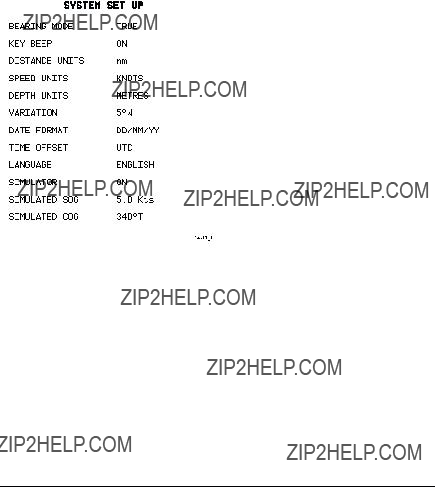
3.Use trackpad up/down to move the highlight up or down the list.
4.When the required parameter is highlighted, use trackpad left/right to step through the settings.
5.When you have reset to the required values, press ENTER to implement the change and return to the set up function bar.
6.Press CLEAR to clear the function bar and return to the chart display.
Note: You can return all the settings to their original factory settings, if required, by performing a factory reset as described in Chapter 6.
The following table lists the System menus and their options, shows the factory default settings and provides space for you to make a note of your new settings. Each parameter is described in the following subsections.
Bearing mode
The mode (MAGnetic or TRUE) of all the bearing and heading data displayed. This is indicated by M or T in the BRG or COG field of the Chart status bar.
Key beep
This setting controls audible feedback resulting from operation of the keys.
Note: Alarms remain active.
Units
You can set the units for distance, speed and depth . The units you set will be used to display all data. However, the distance units do not affect the chart scale, which is always in nautical miles.
Variation
The variation value is the difference between True and Magnetic direction data for heading or bearing values. The Magnetic value is derived from True by applying the user selected value of variation.
The variation is varied in 1?? steps to 30?? East or West. Press trackpad right to move the value eastward, or left to move it westward. The selected value is retained when the unit is switched off. The Default value is zero.
Date format
Set your preferred date format (DD/MM/YY or MM/DD/YY). The selected setting is retained when the unit switched off. The Default is DD/MM/YY.
Time offset
If you wish to display local time, use the trackpad to change from UTC to the required time offset. This can be up to plus or minus 13 hours, in 1 hour steps. The default is UTC.
Language
Select the language in which you wish information to be displayed. The selected language is used for screen text, labels, menus and options. Chart text, provided by the chart card, is not affected.
Simulator
The simulator allows you to operate your RayChart 420 without data from external sources. The options are ON or OFF.
When ON is selected the simulator will generate position, SOG and COG data and use the simulated data in place of any real data.
Note: The simulated data overrides any real data that your display unit is receiving from externally connected equipment.
The position is initially the position of the cursor when the simulator is switched on and the SOG and COG are as selected by the user. The position is updated to reflect the SOG and COG. See Simulated SOG and Simulated COG below.
If a GOTO or Follow is started, the simulator does not use the selected value of COG but, instead, generates a value of COG that simulates the navigation function in progress. When GOTO or Follow is stopped, the user selected value of COG is used.
Simulated SOG
Use horizontal movements of the trackpad to adjust the value of SOG which is adjustable in 1 knot intervals from 00 to 99.
The Default value is zero and the selected value is retained on power down.
If the simulator is switched OFF, the value is shown as dashes and no adjustment is possible.
Simulated COG
Use horizontal movements of the trackpad to adjust the value of COG which is adjustable in 1?? intervals from 000?? to 359??. It wraps around from 000 to 359 and from 359 to 000.
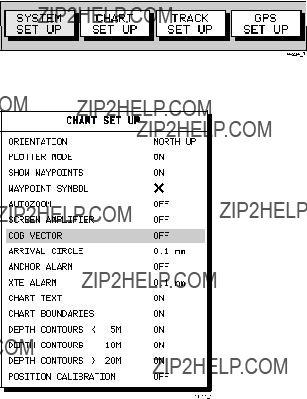
The Default value is zero and the selected value is retained on power down.
If the simulator is switched OFF, the value is shown as dashes and no adjustment is possible.
4.3 Chart set up parameters
The CHART SET UP function allows you to set up the chartplotter according to your system configuration and your personal preferences.
??To set the Chart default parameters:
1.Press the PAGE key to display the SET UP functions:
2.Use the trackpad left/right to highlight the CHART SET UP function and press ENTER to display the Chart Set Up menu:
3.Use trackpad up/down to highlight the required parameter, then use trackpad left/right to select the required setting.
4.When you have reset the required values, press ENTER to clear the menu and return to the set up function bar.
5.Press CLEAR to clear the function bar and return to the normal display.
Note: You can return all the settings to their original factory settings, if
required, by performing a factory reset as described in Chapter 6.

The following table lists the Chart Set up parameters and their options, shows the factory default setting and provides a space for you to make a note of your new default setting. Each parameter is described in the following subsections.
Orientation
The chart orientation is normally North Up, but can be changed to Course Up or Head Up. The orientation modes give the following displays:
???North Up: The chart is displayed with north upwards. This is the default mode and is the only mode available if there is no COG data.
???Course Up: The chart is rotated such that the currently selected course (bearing to the target waypoint) or, if no navigation function is taking place, the current COG value is shown upwards.
To update the Course Up reference whilst Course Up is the current mode, re- select COURSE UP from the set up menu.
If you select a new course, eg. a new target waypoint, the chart displays the new course upwards.
???Head Up: The chart is displayed with the vessel???s current COG upwards. As the heading changes the chart rotates periodically to maintain orientation.
Note: Head Up and Course Up modes are dependent upon a valid GPS fix.
Plotter mode
Plotter mode allows the user to zoom in beyond the level of cartography and continue to use plotter functions. The selected setting is retained when unit switched off.
Show waypoints
This option controls whether or not the waypoints are shown on the Chart display, with their appropriate symbols. The active waypoint, and waypoints in the current route, are always shown.
Waypoint symbol
This option allows selection of the symbol for waypoint display. The selected symbol is used for subsequent waypoints. Existing waypoints are not affected. The selected symbol is retained when the unit switched off.
Autozoom
When autozoom is enabled, commencing any navigation function or selecting FIND SHIP activates Autozoom. When active, this selects the chart range and position such that the vessel and the target waypoint are both on screen but at the largest scale possible. Moving the cursor off the vessel, or changing scale, deactivates Autozoom.
Autozoom will not zoom in beyond the largest cartographic scale (see also Plotter Mode). When in MOB mode, Autozoom is selected automatically and will zoom in as far as possible, irrespective of the selection of Plotter Mode.
Unless MOB is active Autozoom will not be activated if there is no cartridge or if the area being viewed is not covered by the cartridge.
Screen amplifier
Screen amplifier mode makes better use of the screen by positioning the vessel on the screen so as to increase forward visibility. The screen amplifier is only active when the cursor is ???homed??? on the vessel.
COG vector
When ON, a vector line from the vessel is drawn in the direction of COG. This line extends to the edge of the screen. If COG is not valid, no line is drawn. The selected setting is retained when the unit switched off.
Arrival circle
The selected value is used as the arrival circle radius. When approaching the target waypoint, this is the distance at which the arrival alarm sounds. The selected setting is retained when unit switched off. Arrival criteria are met when the arrival circle is entered or a line perpendicular to the desired track and passing through the waypoint is crossed.
Anchor alarm
The selected value is used as the anchor alarm distance. If the vessel moves outside of the selected distance from its position (at the time that the alarm was enabled) the alarm sounds and an alarm message is displayed.
To silence the alarm, press any key. This removes the warning and resets the distance, ie. the alarm will not sound again unless the vessel moves the selected distance from its position (at the time that the alarm was silenced). The alarm is set to OFF on power up.
XTE alarm
The selected value is used as the cross track error limit. The alarm sounds when the cross track error exceeds the selected limit when a GOTO or a Route Follow is in progress and an alarm message is displayed.
Chart text
When ON, Chart text, eg. place names are shown on the screen. The selected setting is retained when the unit switched off.

Chart boundaries
When ON, Chart boundary lines are shown on the screen. The selected setting is retained when the unit switched off.
Depth contours <5M
When ON, depth contours less than 5 metres are shown. The selected setting is retained when the unit switched off.
Depth contours 10M
When ON, depth contours of 10 metres are shown. The selected setting is retained when the unit switched off.
Depth contours >20M
When ON, depth contours greater than 20 metres are shown. The selected setting is retained when the unit switched off.
Position calibration
When ON, all position data is offset from WGS 84 by the amount of the selected calibration and is suffixed by (c). The selected setting is retained when the unit switched off. The default calibration offset is zero.
?? To perform position calibration:
1.Using horizontal trackpad movements, select SET CAL.
The menu is removed and a single function and help text are shown:
2.Using the trackpad, set the value of offset required. The distance and bearing of cursor from vessel is displayed in the Status Bar as BRG and RNG.
3.Press ENTER to confirm the selected offset value or CLEAR to reset the value to zero and return to the Chart Set Up menu.
An offset of 2nm or less is applied to all position data equal to the range and bearing between the WGS 84 position and the position entered. The menu returns with ON highlighted.
Note: Pressing ENTER with a selected offset of more than 2nm gives a warning message which is cleared on any key press. The Calibration Set Up mode maintains and the user can either reselect an acceptable offset or press CLEAR to reset the value to zero and return to the Set Up menu.
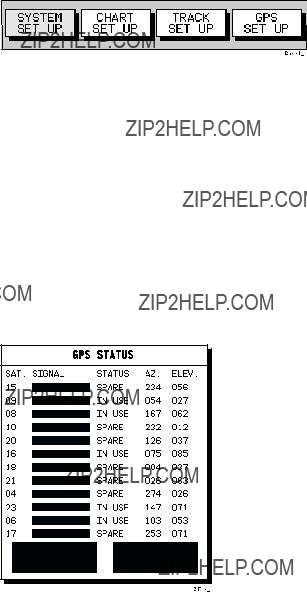
4.4 GPS setup
The GPS set up page provides information for the status of the tracked navigation satellites plus HDOP and satellite Fix Status. It also provides the ability to set up a Differential GPS (RC420D), by manually retuning it to a different differential beacon.
??To select GPS Set Up:
1.Press the PAGE key to display the SET UP functions:
2.Use the trackpad to highlight the GPS SET UP function and press ENTER to display the GPS SET UP menu.
The GPS Status window is displayed as shown below. This provides, for each tracked satellite, the satellite number, a graphical signal strength bar, status, azimuth angle and its elevation angle from your vessel.
Positional accuracy is dependent upon these parameters; in particular, the azimuth and elevation angles are used in a triangulation process to calculate your position. HDOP (Horizontal Dilution Of Position) is a measure of this accuracy; a higher figure signifies greater error. In ideal circumstances, the figure should be in the region of 1.0. The Fix Status can indicate:
???NO FIX, where no satellite fix can be acquired
???FIX OK, where a satellite fix has been acquired
???
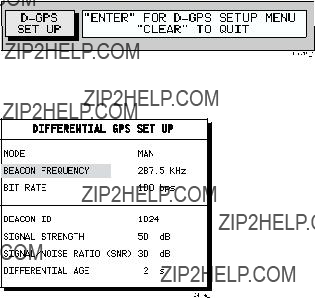
The
??To tune a differential GPS to another beacon:
1. Press ENTER; the Differential GPS Setup menu is displayed:
2.Using vertical trackpad movements, select MODE.
3.Using horizontal trackpad movements, alternates between MAN and AUTO; select MAN to set the beacon to manual tuning.
4.Using vertical trackpad movements select BEACON FREQUENCY and use horizontal trackpad movements to set the required beacon frequency. The frequency is adjustable between 283.5kHz and 325.0kHz in 0.5kHz steps.
5.Using vertical trackpad movements select BIT RATE and use horizontal trackpad movements to set the bit rate value. The bit rate value is selectable as either 100bps or 200bps.
6.Press ENTER to select the new beacon settings and return to the GPS Status window, then press CLEAR again to return to the Setup functions.
The Beacon ID indicates the beacon transmitter reference number. The received signal strength and signal to noise ratio (SNR) are indicated in dB. The SNR provides a measure of the quality of the received signal and is dependent upon signal strength. The greater the signal strength, the better the SNR is likely to be. Generally, the best signal is determined by the distance from the transmitter and the obstacles in between.
Differential Age indicates the time elapsed since the last differential beacon fix.
A list of beacon stations is available from the your local Raytheon distributor or the Raytheon Marine website: www.raymarine.com
Chapter 5: Installation
5.1 Introduction
This chapter provides instructions to assist in planning the installation of the RayChart 420 Chartplotter aboard your vessel.
Note: If you wish to practice using the RayChart 420 before installation, you can connect it, via a 1A quick blow fuse, to a 12Vdc power supply and operate it using the simulator mode, as described in Chapter 2 Getting Started.
EMC Installation Guidelines
All Raytheon equipment and accessories are designed to the best industry standards for use in the leisure marine environment.
Their design and manufacture conforms to the appropriate Electromagnetic Compatibility (EMC) standards, but correct installation is required to ensure that performance is not compromised. Although every effort has been taken to ensure that they will perform under all conditions, it is important to understand what factors could affect the operation of the product.
The guidelines given here describe the conditions for optimum EMC performance, but it is recognised that it may not be possible to meet all of these conditions in all situations. To ensure the best possible conditions for EMC performance within the constraints imposed by any location, always ensure the maximum separation possible between different items of electrical equipment.
For optimum EMC performance, it is recommended that wherever possible:
???All Raytheon equipment and cables connected to it are:
???At least 1 m (3 ft) from any equipment transmitting or cables carrying radio signals e.g. VHF radios, cables and antennas. In the case of SSB radios, the distance should be increased to 2 m (7 ft).
???More than 2 m (7 ft) from the path of a radar beam. A radar beam can normally be assumed to spread 20 degrees above and below the radiating element.
???The equipment is supplied from a separate battery from that used for engine start. Voltage drops below 10V in the power supply to our products, and starter motor transients, can cause the equipment to reset. This will not damage the equipment, but may cause the loss of some information and may change the operating mode.
???Raytheon specified cables are used at all times. Cutting and rejoining these cables can compromise EMC performance and so must be avoided unless doing so is detailed in the installation instructions.
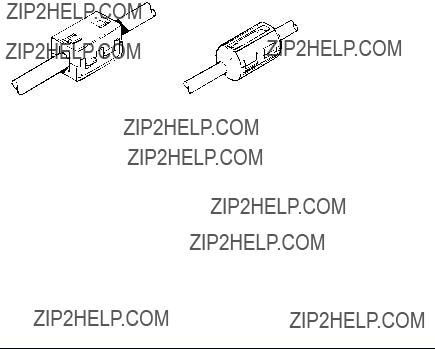
???If a suppression ferrite is attached to a cable, this ferrite should not be removed. If the ferrite needs to be removed during installation it must be reassembled in the same position.
Suppression ferrites
The following illustration shows typical cable suppression ferrites fitted to Raytheon equipment. Always use the ferrites supplied by Raytheon.
Connections to other equipment
If your Raytheon equipment is to be connected to other equipment using a cable not supplied by Raytheon, a suppression ferrite MUST always be fitted to the cable close to the Raytheon unit.
5.2 Unpacking and inspecting the components
Unpack your RayChart 420 Chartplotter carefully. Retain the carton and packing materials in the event that you need to return the unit for service.
Check that you have all the correct system components. These depend on your system package:
Items Missing?
If any of the above items are missing or damaged, please contact your Raytheon dealer or our Product Support Department to obtain replacement parts. Please
note that missing or damaged items cannot be replaced without proof of purchase.
Registering this Product
When you have checked that you have all of the listed components, please take the time to complete the
5.3 Location
This section provides information affecting the possible location of the unit for ease of use, access for servicing and its position relative to the power supply.
Selecting the best location
The unit can be mounted using the trunnion (yoke) bracket, or panel mounted using the optional Panel Mounting Kit.
When planning the installation of your RayChart 420, the following points should be considered to ensure reliable and trouble free operation:
???Convenience: The unit should be installed in a convenient position where it can be viewed straight on or with a viewing angle of less than 35??. You may wish to apply power, before you install the unit, to determine the best viewing angle prior to fixing. The mounting location should be easily accessible to allow operation of the front panel controls.
???Access: There must be sufficient space behind the display unit to allow cable connections to the rear panel connectors, avoiding tight bends in the cable. At least 4cm should be allowed at the right to enable chart cards to be inserted and removed.
???Interference: The selected location should be far enough away from devices that may cause interference, such as motors and generators (see the EMC guidelines earlier in this section).
???Cable runs: The unit must be located near a dc power source. The power cable supplied is 1.5m, but a longer cable can be used if required. Power must be supplied via a 1A quick blow fuse or circuit breaker. Refer to Section 5.6 Cabling.
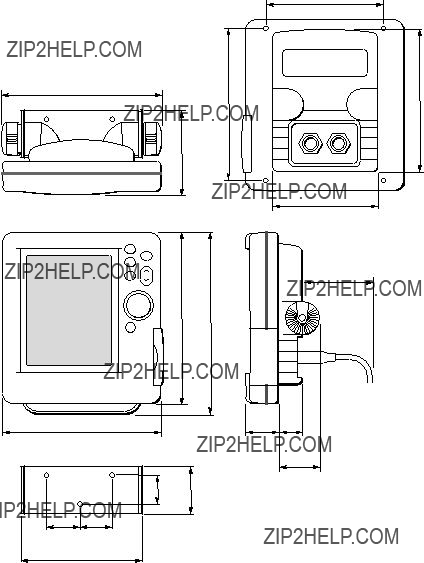
???Environment: The unit should be protected from physical damage, heat sources and excessive vibration. Although the unit is waterproof, it is good practice to mount it in a protected area away from prolonged and direct exposure to rain and/or salt spray.
The dimensions of the unit, including the bracket, are shown in the following diagram.
170mm (6.7in)
112 mm (4.4 in)
MOB
GO TO
168 mm (6.6 in)
122 mm (4.8 in)
80 mm (3.15 in) plug clearance
43.5 mm
(3.5 in)
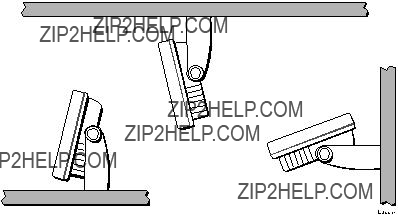
5.4 Connecting to other equipment
The unit transmits navigation and waypoint data on NMEA and, therefore, can be connected to an NMEA(1) compatible autopilot or compatible instrument repeater(s). The navigation data transmitted by the chartplotter is detailed in Appendix B to this handbook.
5.5 Mounting the chartplotter
Trunnion (yoke) mounting
The display unit can be conveniently mounted on a dash area, chart table, bulkhead or deckhead, as shown in the following diagram.
1.Loosen the trunnion knobs and remove the trunnion from the display unit.
2.Mark the locations of the trunnion screw holes on the mounting surface.
3.Use the screws supplied to fix the trunnion at the marked locations.
4.Fit the unit to the trunnion, adjust the display angle and tighten the knobs.
5.Connect the Power/NMEA and GPS cables to the unit, avoiding tight bends in the cables.
Panel mounting
CAUTION:
Make sure that there are no hidden electrical wires or other items behind the location before proceeding. Make sure that there is sufficient rear access for mounting and cabling. Allow at least 4cm at the right hand side of the display to enable chart cards to be inserted and removed.
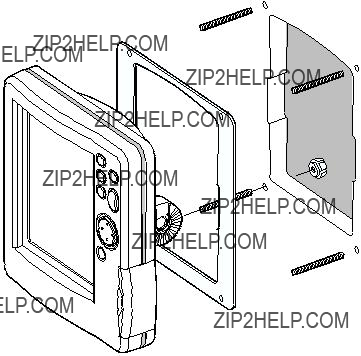
The unit can be panel mounted, using the
??Panel mount the unit as follows:
1.Check the selected location for the unit. A clear, flat area at least 175mm (7in) wide by 190mm (7??in) high, with at least 90mm (3??in) of clearance behind the panel, is required.
2.Unpack the (optional)
3.Using the supplied template, trace out the display unit
4.To provide start holes for removing the
5.Using a suitable saw, cut along the inside edge of the
6.With the trunnion (yoke) and knobs removed, make sure that the unit fits in the
7.Drilloutthefour5mm (3/16 in) securing holes as indicated on the template. It is recommended that a 1mm (1/16 in) pilot hole is drilled first.
8.Screw the studs into the vacant holes at the rear of the unit, hand tight only.
9.Place the gasket on the unit and slide the unit into the panel
10.Secure the unit with the thumb nuts, hand tight only.
D4722_1
5.6 Cabling
Introduction
The following points need to be considered before installing the system cables:
???The minimum requirements are a power cable and a connection from the associated GPS. Additional cables will be required if you are connecting to other equipment.
???All cables should be adequately cleated and protected from physical damage and exposure to heat. Avoid running cables through bilges or doorways, or close to moving or hot objects.
???Where a cable passes through an exposed bulkhead or deckhead, a watertight gland or swan neck tube should be provided.
You need to run the following cables:
???POWER/NMEA cable, supplied with the unit. This has a connector at one end for connecting to the unit and seven cores at the other for connecting the power supply and (optionally) NMEA.
???GPS cable from the associated GPS antenna with a connector at one end.
Chartplotter connectors
The following connectors are provided at the rear of the chartplotter:
???GPS, for connection to the associated GPS receiver.
???POWER/NMEA, for 12Vdc power connection and NMEA inputs/outputs.
GPS connector
The GPS connector provides power and data connections to the associated GPS (RC420) or dGPS (RC420D).
??Connect the GPS/dGPS using the attached cable, as follows:
1.Mount the GPS/dGPS according to its accompanying Installation Guide.
2.Feed the cable through to the rear of the chartplotter.
3.Coil up any unused cable in an appropriate safe space out of view. Do not bend the cable tighter than 100mm (4in) radius.
Note: If the supplied cable is too short, use an extension cable (Part# E35003) available from your local Raytheon dealer.
Connections to the GPS connector on the rear of the display unit are detailed in the following table:
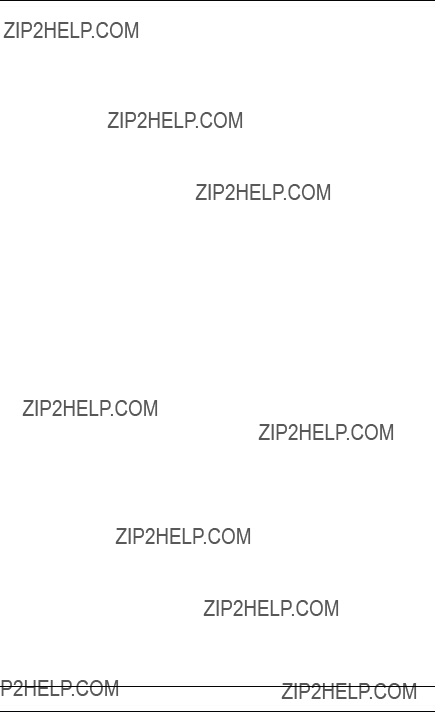
POWER/NMEA connector
CAUTION:
If you do not have a breaker in your power circuit, you must fit an
This unit is not intended for use on positive ground vessels.
The power connections should be made at a dc power distribution panel through an isolator switch, a 1A circuit breaker or a 1A quick blow fuse. Check that all connections are clean and tight.
The dc power system should be either:
???Negative ground, with the negative battery terminal connected to the vessel???s ground.
???Floating, with neither battery terminal connected to the vessel???s ground.
The chartplotter is intended for use on vessels??? dc power systems operating in the range 10.0Vdc to 18.0Vdc (ie. 12V systems, not 24V or 32V systems). A 1.5m (5ft) power cable is supplied .
If a longer power cable run is required, use the supplied power cable to connect to the unit, then use a suitable connector block to connect the free end to the extension cable. The supplied power cable has a
Longer power cable runs may require larger wire gauges to minimise any voltage drop in the cable. In order to determine the correct supply cable size if the power cable must be extended, estimate the length of cable between the vessel???s main power source and the connector block then select the wire size indicated by the distance in the following table.
Maximum Extension Power Cable Lengths (m)

The dc power and NMEA inputs/outputs should be connected to the POWER/NMEA connector at the rear of the RayChart 420. The connector pin functions are detailed in the following table.
??Connect the power supply using the standard power cable supplied, as follows:
1.Connect the moulded power plug to the POWER/NMEA connector on the rear of the chartplotter. Run the free end back to the vessel???s distribution panel or, if insufficient cable length to a junction box.
2.Cut the cable to length and connect the red wire, via a fuse, to the +ve battery terminal and the black wire to 0V
3.Use a suitable junction box to connect to NMEA equipment if required.
4.Cut any unused cores short or insulate and tape back.
Note: If the power connections are accidentally reversed, the system will not function. Use a volt meter to check that the input power leads are connected with the correct polarity.
5.7 System Check and Initial Switch On
When you have installed your Chartplotter and made all the connections, you need to check your installation before using the system for navigation. If you encounter any problems, refer to Chapter 6, Maintenance and Fault Finding.
EMC Conformance
Always check the installation before going to sea to make sure that it is not affected by radio transmissions, engine starting etc.
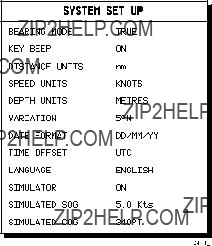
System Check
Before performing the functional test, check that:
???All securing bolts are fully tightened and mechanical locking arrangements as specified are in place.
???All connections have been made.
???All connecting wires are secured and protected as necessary.
Initial Switch On
To switch on the display unit, press and hold the POWER key until the unit beeps.
If necessary, adjust the lighting and contrast (see Chapter 2).
If required, change the default language settings as follows:
1.Press the PAGE key to display the setup function bar.
2.Using trackpad left/right, select the SYSTEM SET UP function and press
ENTER.
The SYSTEM SET UP menu is displayed, listing the parameters and their current settings. The complete list, which you can scroll through, is shown in the following illustration:
3.Using trackpad up/down, select the LANGUAGE option.
4.Using trackpad left/right, select the required language.
5.Press ENTER to return to the setup functions. The chartplotter now uses the selected language.
6.Press CLEAR to return to the normal chart screen.
Checking the Chartplotter Operation
To confirm that your chartplotter is operating correctly, perform the following checks:
1.Without a Navionics Microchart?? card fitted, verify that the world map is visible.
2.Press the trackpad left/right, up/down and check cursor movement and normal scrolling action.
3.Insert a Navionics Microchart?? card for the area of your vessel.
Use the RANGE key to
4.Ensure that position data is available; use the FIND SHIP function to check that the cursor is fixed on the vessel symbol which is correctly positioned at the centre of the chart display, see Chapter 3, Operation.

Chapter 6: Maintenance & fault finding
This chapter provides information on routine maintenance and on possible causes of problems you may experience with your RayChart 420 Chartplotter.
6.1 Maintenance
Warnings
The chartplotter contains high voltage and specialised circuits only accessible to qualified service technicians - there are no user serviceable parts or adjustments and the operator should not attempt to service the equipment. The operator should not remove the rear cover .
Routine checks
The Chartplotter is a sealed unit. Maintenance procedures are therefore limited to the following periodical checks:
???Wipe the display unit clean with a damp cloth.
???Examine the cables for signs of damage, such as chafing, cuts or nicks.
???Check that the cable connectors are firmly attached and that the connections to the vessel???s dc power are clean and tight.
???Ensure that the cartridge cover is always fitted correctly.
Note: Never use chemical or abrasive materials to clean the chartplotter. If the unit is dirty, wipe it with a clean, damp cloth.
Servicing and Safety
Raytheon equipment should be serviced only by authorised Raytheon service technicians. They will ensure that service procedures and replacement parts used will not affect performance. There are no user serviceable parts in any Raytheon product.
Some products generate high voltages, so never handle the cables/connectors when power is being supplied to the equipment.
When powered up, all electrical equipment produces electromagnetic fields. These can cause adjacent pieces of electrical equipment to interact with one another, with a consequent adverse effect on operation. In order to minimise these effects and enable you to get the best possible performance from your Raytheon equipment, guidelines are given in the installation instructions, to enable you to ensure minimum interaction between different items of equipment, i.e. ensure optimum Electromagnetic Compatibility (EMC).

Always report any
In some installations, it may not be possible to prevent the equipment from being affected by external influences. In general this will not damage the equipment but it can lead to spurious resetting action, or momentarily may result in faulty operation.
6.2 Resetting the system
Two types of reset are available for the Chartplotter:
???
???Factory Reset: This resets all values back to their original factory settings.
Note: Take care - factory reset clears all Waypoint and Route databases.
At
??To perform a factory reset:
1.Power off the unit.
2.Press and hold CLEAR whilst powering up until <Erase backup procedure> is displayed.
3.Either press CLEAR to abort Factory Reset and resume normal
4.Press ENTER again; the unit restarts as for a first time Power Up with all values reset to their original factory settings
Note: The factory default settings are listed in Chapter 4.

6.3 Problem solving
Prior to packing and shipping, all Raytheon products are subjected to comprehensive test and quality assurance programmes. However, if this unit should develop a fault, please refer to the following table to identify the most likely cause and the corrective action required to restore normal operation.
If you still have a problem after referring to the table, contact your local dealer, national distributor or Raytheon Product Support for further advice.
Always quote the product serial number.
Fault finding
6.4 Worldwide support
In the first instance, contact the authorised distributor in your own country. A list of worldwide distributors is supplied with your system.
Or visit the Raytheon World Wide Web site:
www.raymarine.com
How to contact Raytheon Marine (US)
For accessories and parts
Many Raytheon accessory items and parts can be obtained directly from your authorized Raytheon dealer. However, if you are in need of an item not available from the retailer, please contact:
Sales & Order Services are available Monday through Friday 8:15am to 5:00pm Eastern Standard Time.
Please have the Raytheon item or part number ready when calling if placing an order . If you are not sure which item is appropriate for your unit, you should first contact the Technical Support Department at:
For technical support
Or visit the Raytheon Marine World Wide Web site:
www.raymarine.com
Our Technical Support specialists are available to answer questions about installing, operating and
rmc_tech_raytheon@raymarine.com
For product repair and service
In the unlikely event your Raytheon unit should develop a problem, please contact your authorized Raytheon dealer for assistance. The dealer is best equipped to handle your service requirements and can offer timesaving help in getting the equipment back into normal operation.
In the event that repairs can not be obtained conveniently, product service may also be obtained by returning the unit to Raytheon???s Product Repair Center using the prepaid UPS shipping tag supplied with your unit to:
Raytheon Product Repair Center
22 Cotton Road Unit H
Nashua, NH 03063
The Product Repair Center is open Monday through Friday 8:15am. to 5:00pm Eastern Standard Time. All products returned to the Repair Center are registered upon receipt. A confirmation letter will be sent to you acknowledging the repair status and the product???s reference number.
Should you wish to inquire about the repair status of your unit, contact the Product Repair Center at
How to contact Raytheon Marine (Europe)
Raytheon Marine Company
Anchorage Park
Portsmouth
PO3 5TD England
Tel: +44 (0)23 9269 3611
Fax: +44 (0)23 9269 4642
For accessories and parts
In Europe, Raytheon support, service, accessories and parts may be obtained from your authorised dealer. Please refer to the lists of component part numbers and accessories in Chapter 5, Installation and have the Raytheon part number ready when contacting your dealer.
If you are not sure which item is appropriate for your unit, you should first contact the Customer Services Department .
For technical support
The Customer Services Department handles enquiries concerning installation, operation, fault diagnosis and repair.
Our technical support staff may also be reached via email at:
techsupra@raytheon.com

Appendix A: Specification
* Differential GPS

Appendix B: NMEA data
Appendix C: List of abbreviations
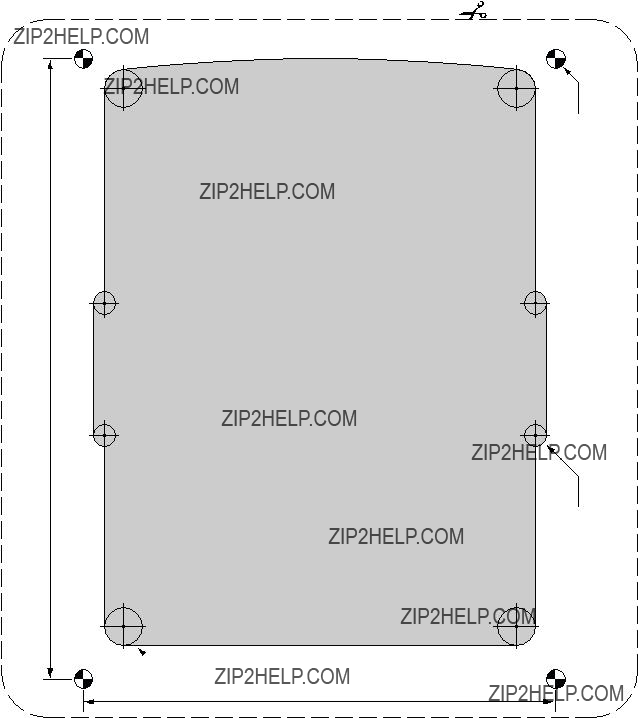
164.2 mm (6.46 in)
Drill hole
5 mm (3/16") diameter
(4 positions)
Cut out shaded area only
Drill hole
6 mm (1/4") diameter
(4 positions)
 Drill hole 10 mm (3/8") diameter (4 positions) 125 mm (4.92 in)
Drill hole 10 mm (3/8") diameter (4 positions) 125 mm (4.92 in)
Limited Warranty Certificate
Raytheon Marine Company warrants each new Light Marine/Dealer Distributor Product to be of good materials and workmanship, and will repair or exchange any parts proven to be defective in material and workmanship under normal use for a period of 2 years/24 months from date of sale to end user, except as provided below.
Defects will be corrected by Raytheon Marine Company or an authorized Raytheon dealer. Raytheon Marine Company will, except as provided below, accept labor cost for a period of 2 years/24 months from the date of sale to end user. During this period, except for certain products, travel costs (auto mileage and tolls) up to 100 round trip highway miles and travel time of 2 hours, will be assumed by Raytheon Marine Company only on products where proof of installation or commission by authorised service agents, can be shown.
Warranty Limitations
Raytheon Marine Company Warranty policy does not apply to equipment which has been subjected to accident, abuse or misuse, shipping damage, alterations, corrosion, incorrect and/or
Except where Raytheon Marine Company or its authorized dealer has performed the installation, it assumes no responsibility for damage incurred during installation.
This Warranty does not cover routine system checkouts or alignment/calibration, unless required by replacement of part(s) in the area being aligned.
A suitable proof of purchase, showing date, place, and serial number must be made available to Raytheon Marine Company or authorized service agent at the time of request for Warranty service.
Consumable items, (such as: Chart paper, lamps, fuses, batteries, styli, stylus/drive belts, radar mixer crystals/ diodes,
Magnetrons, Cathode Ray Tubes (CRT), hailer horns and transducers are warranted for 1 year/12 months from date of sale. These items must be returned to a Raytheon Marine Company facility.
All costs associated with transducer replacement, other than the cost of the transducer itself, are specifically excluded from this Warranty.
Overtime premium labor portion of services outside of normal working hours is not covered by this Warranty.
Travel cost allowance on certain products with a suggested retail price below $2500.00 is not authorized. When/ or if repairs are necessary, these products must be forwarded to a Raytheon Marine Company facility or an authorized dealer at owner???s expense will be returned via surface carrier at no cost to the owner.
Travel costs other than auto mileage, tolls and two (2) hours travel time, are specifically excluded on all products. Travel costs which are excluded from the coverage of this Warranty include but are not limited to: taxi, launch fees, aircraft rental, subsistence, customs, shipping and communication charges etc..
Travel costs, mileage and time, in excess to that allowed must have prior approval in writing.
TO THE EXTENT CONSISTENT WITH STATE AND FEDERAL LAW:
(1)THIS WARRANTY IS STRICTLY LIMITED TO THE TERMS INDICATED HEREIN, AND NO
OTHER WARRANTIES OR REMEDIES SHALL BE BINDING ON RAYTHEON MARINE COMPANY
INCLUDING WITHOUT LIMITATION ANY WARRANTIES OF MERCHANTABLE OR FITNESS FOR
A PARTICULAR PURPOSE.
(2)Raytheon Marine Company shall not be liable for any incidental, consequential or special (including punitive or multiple) damages.
All Raytheon Marine Company products sold or provided hereunder are merely aids to navigation. It is the responsibility of the user to exercise discretion and proper navigational skill independent of any Raytheon equipment.
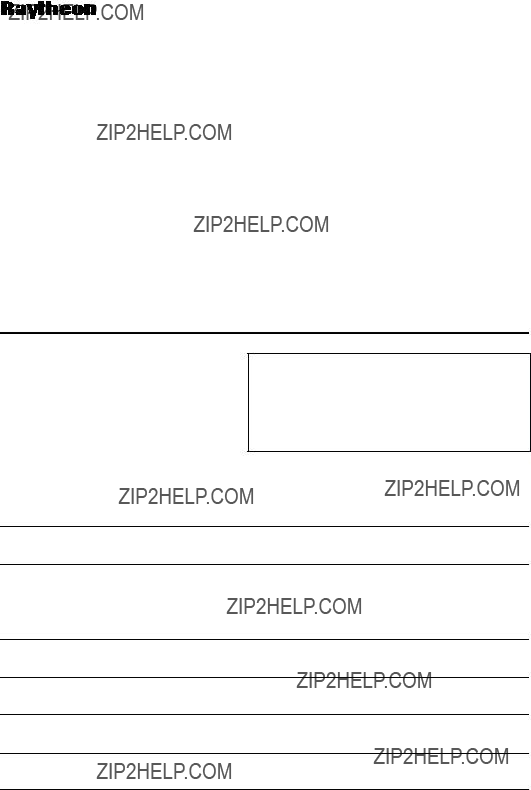
Factory Service Centers
Stick barcode label here
Dealer Address
Commissioned by
Commissioning date
Owner???s name
Mailing address
This portion of card should be completed and retained by the owner.